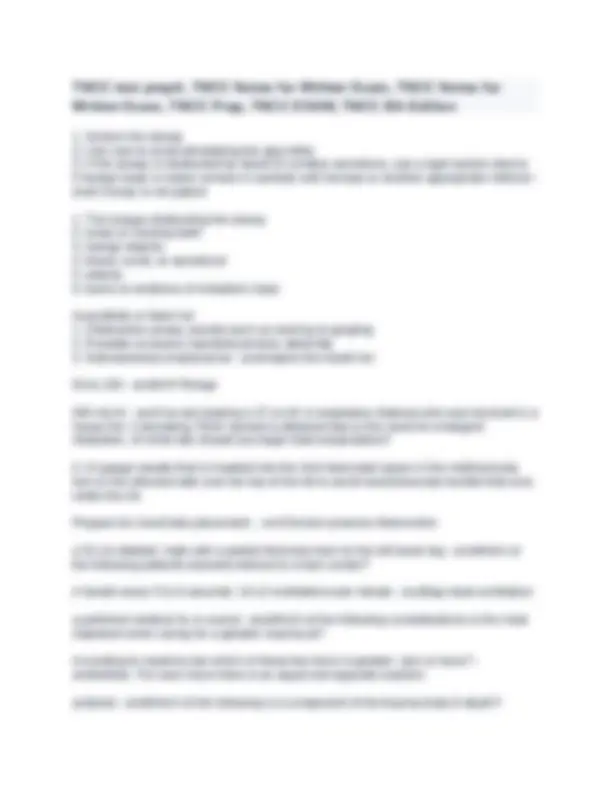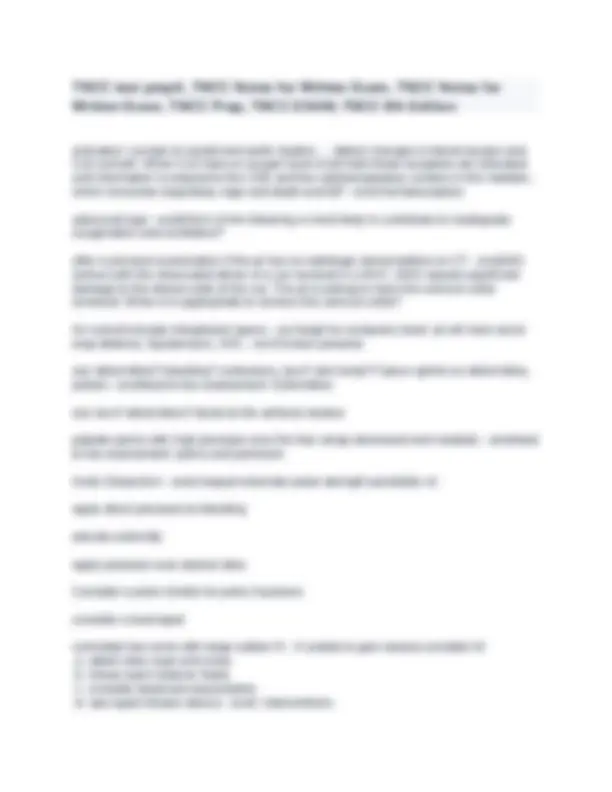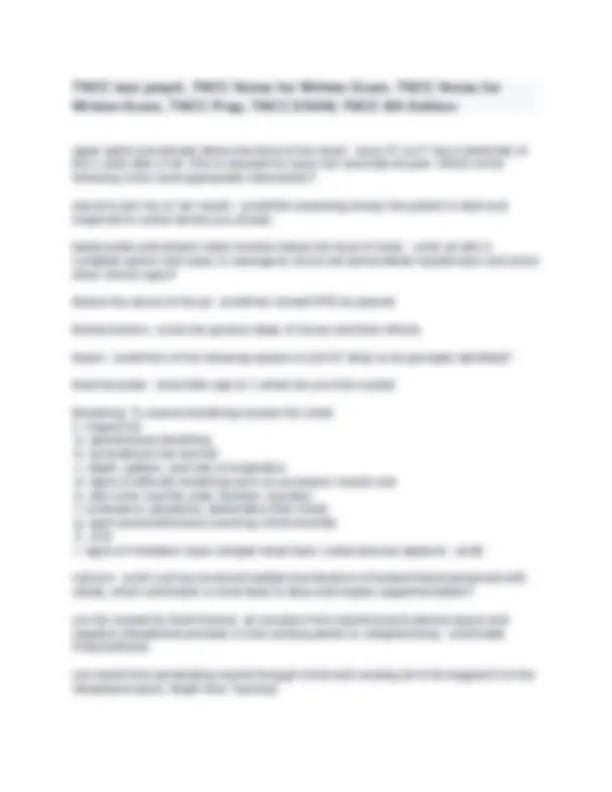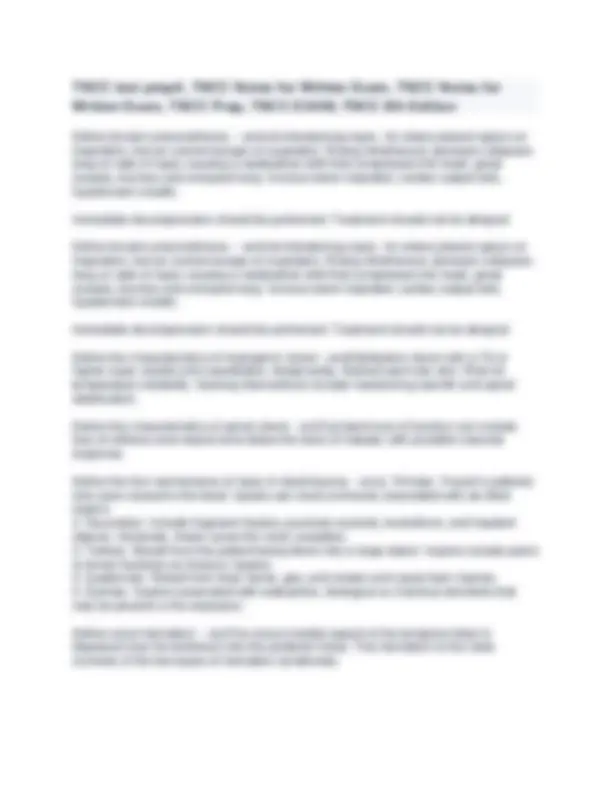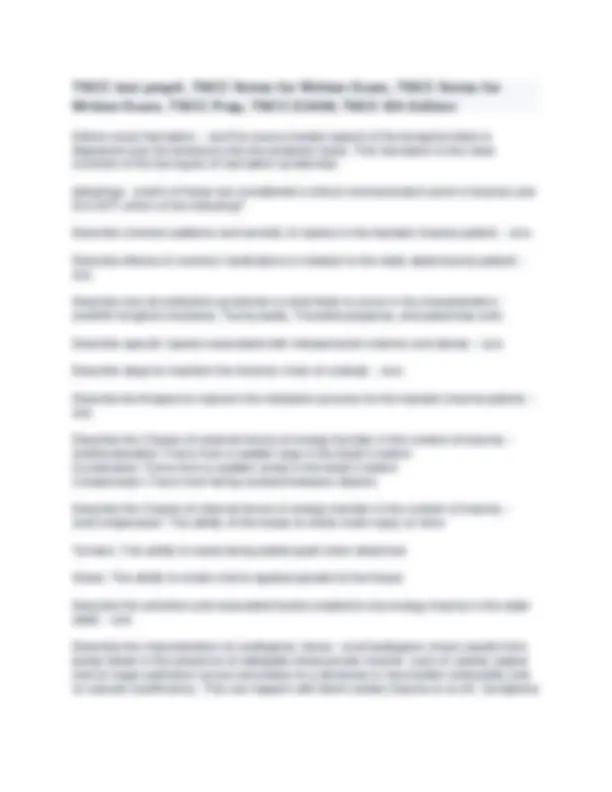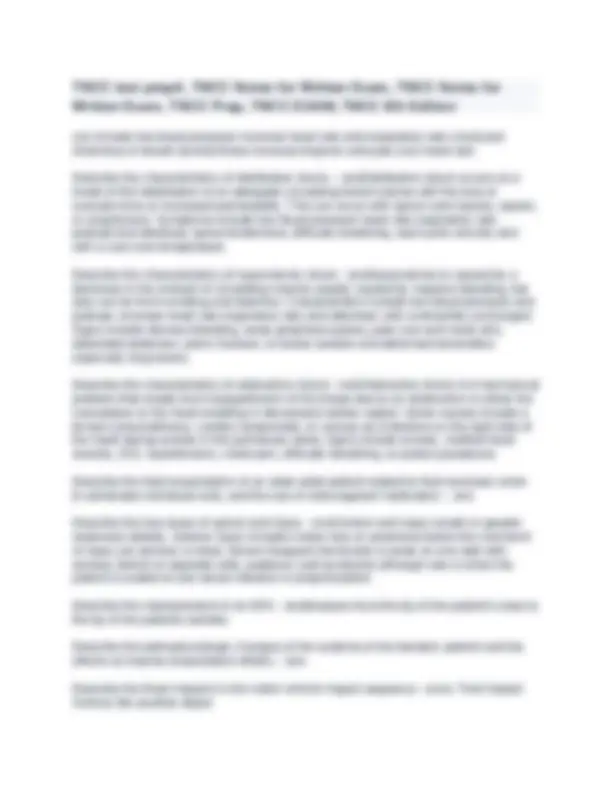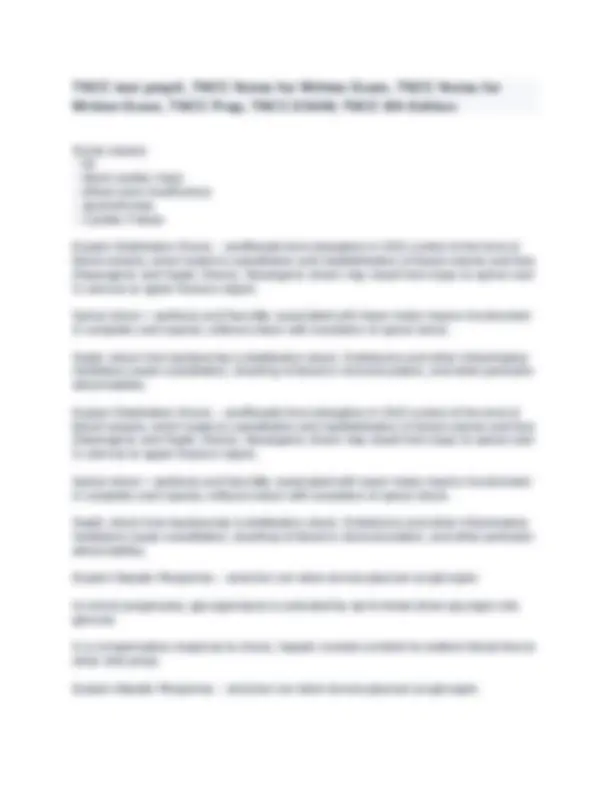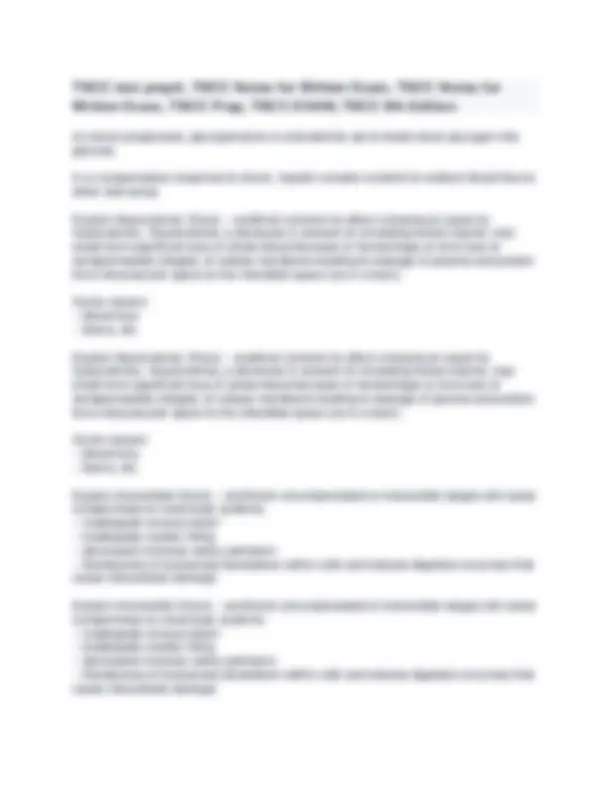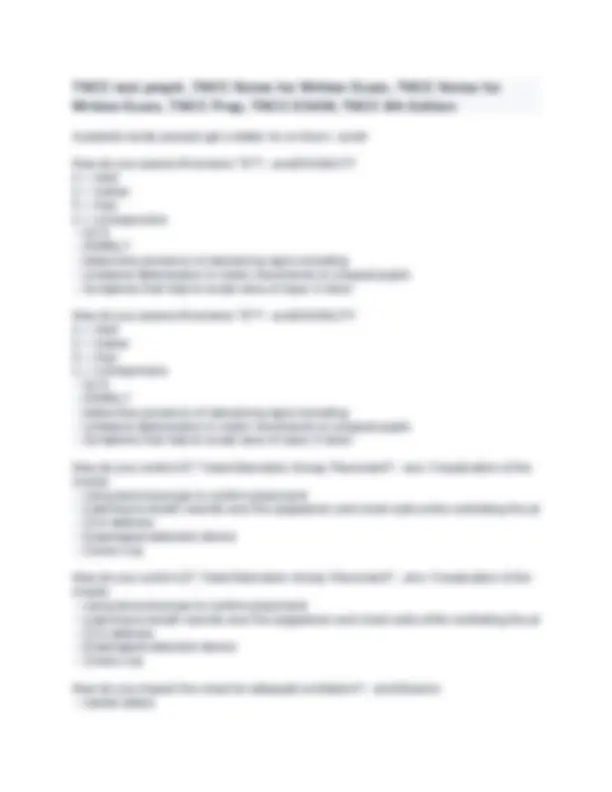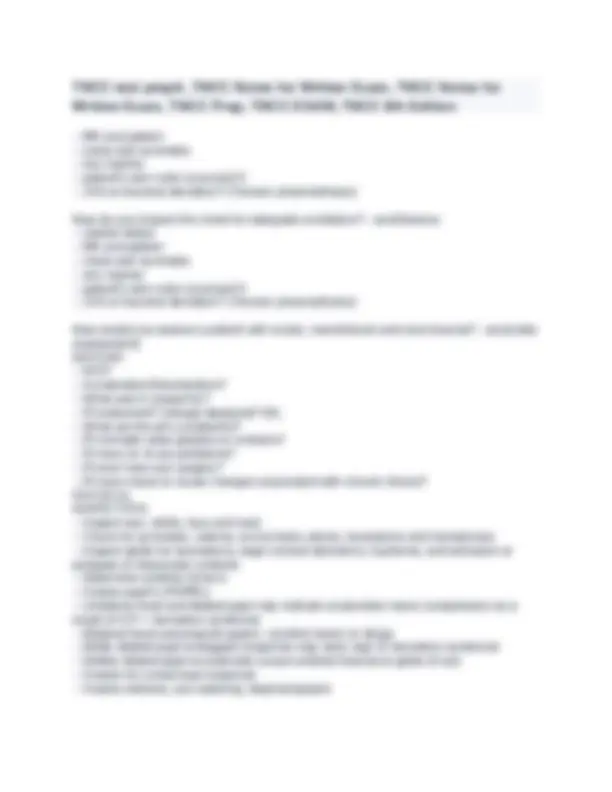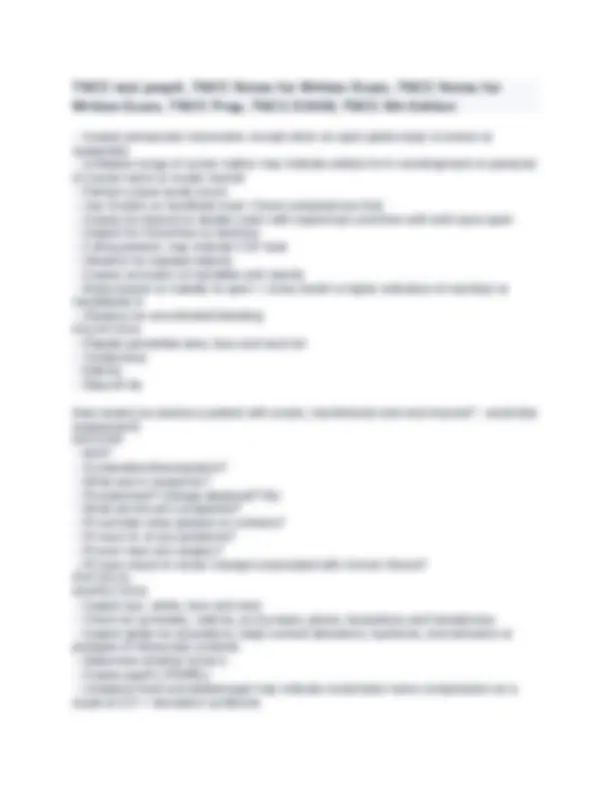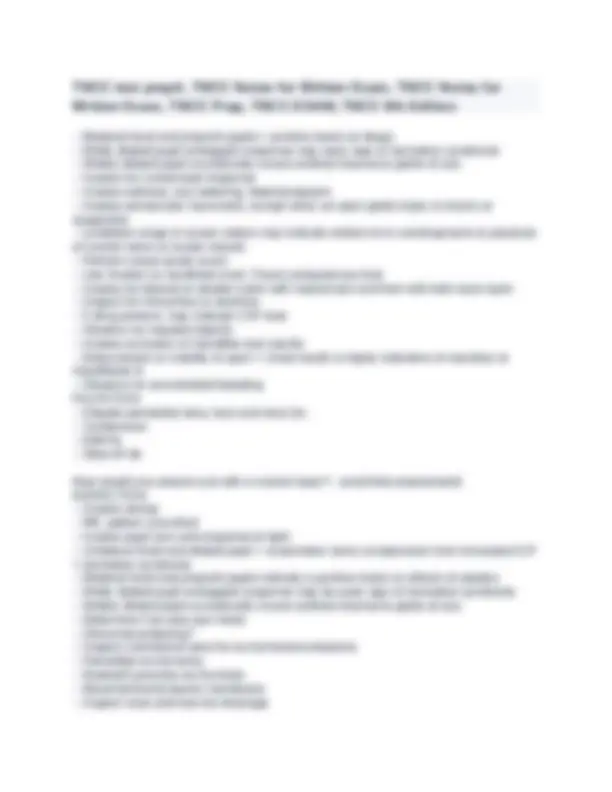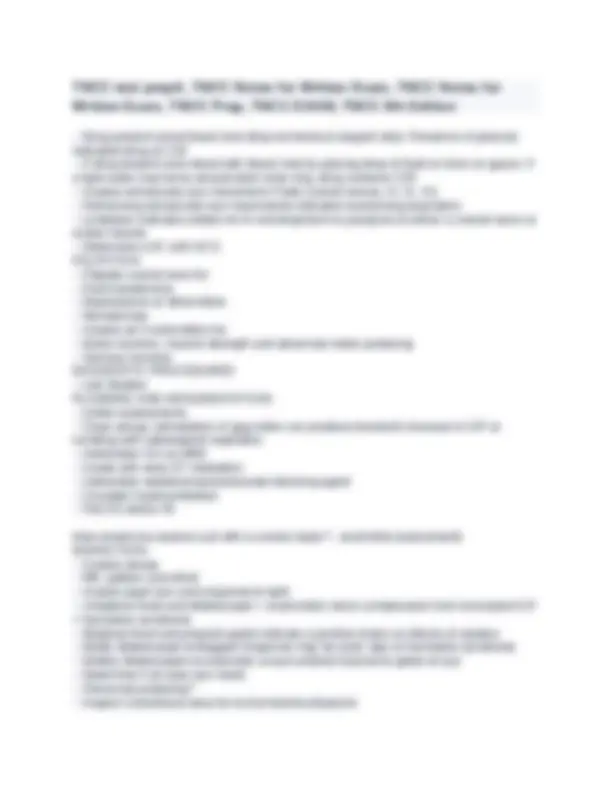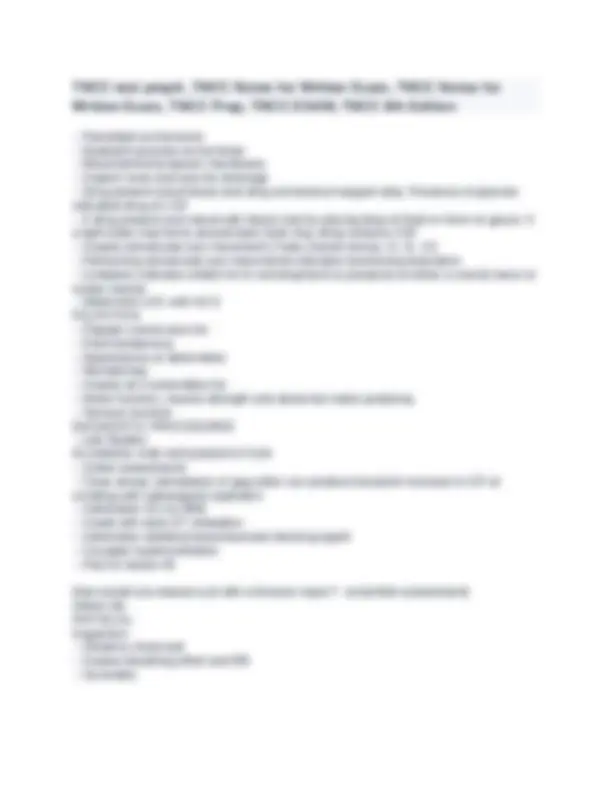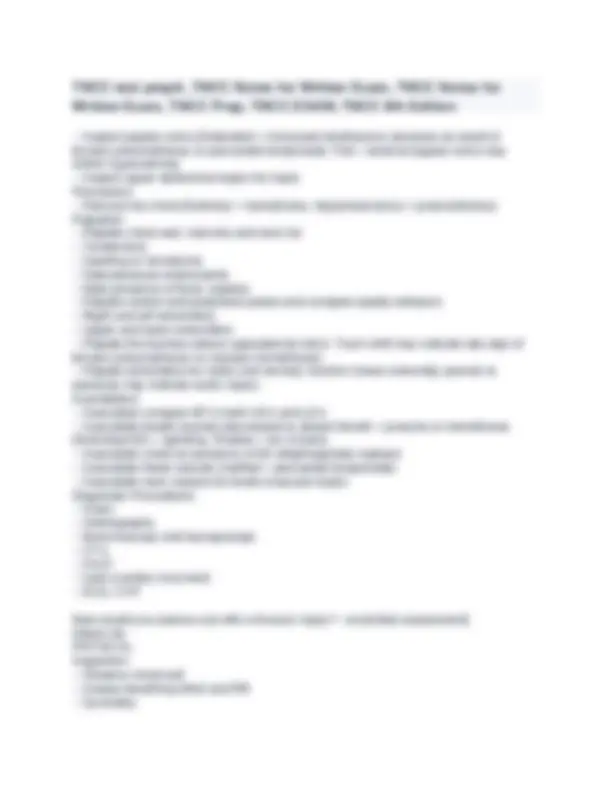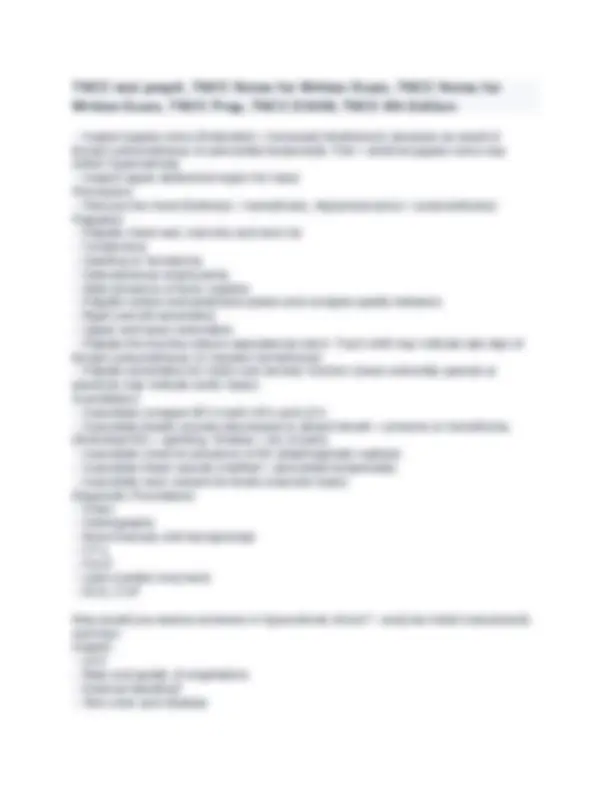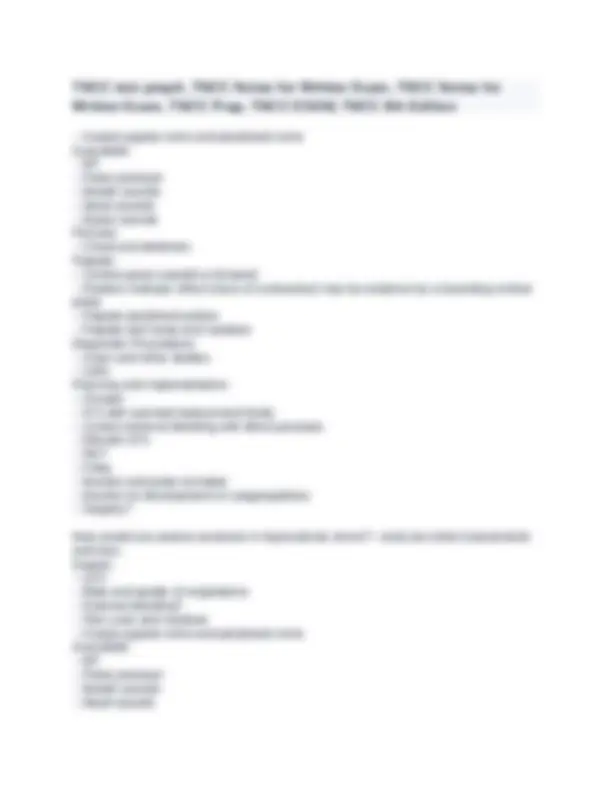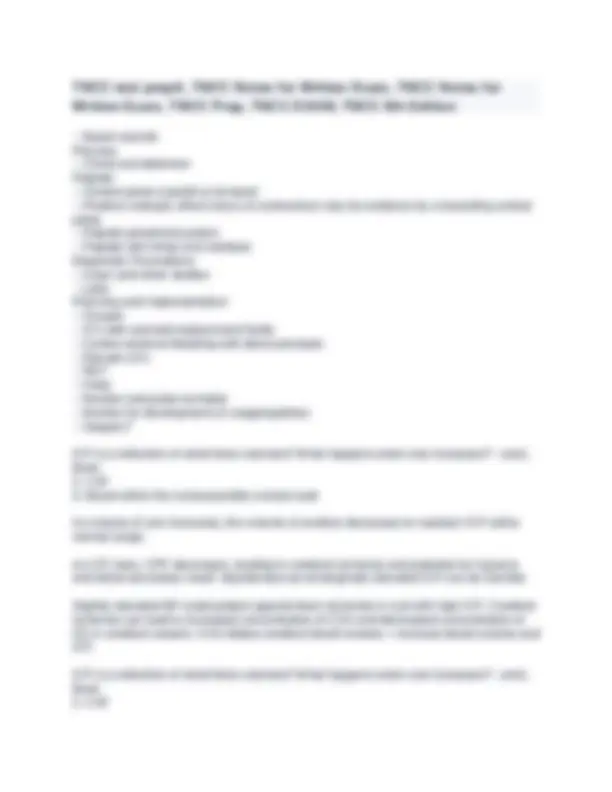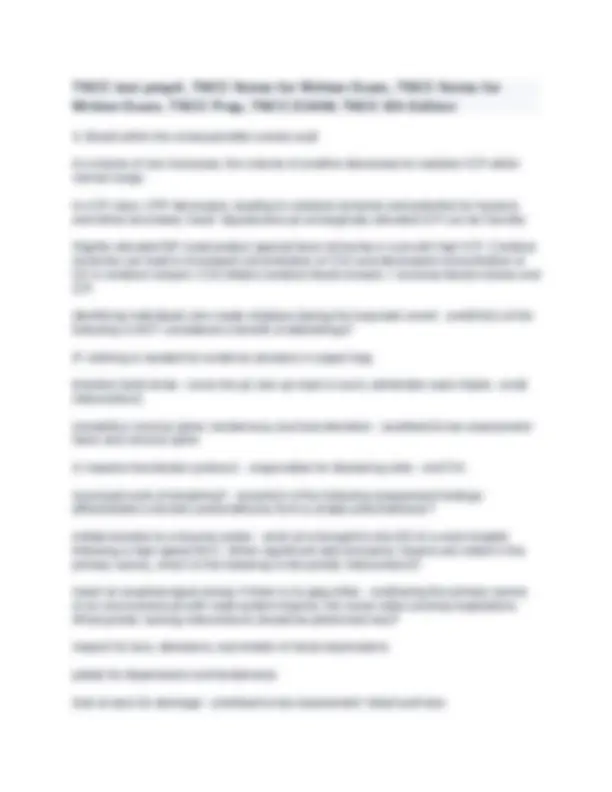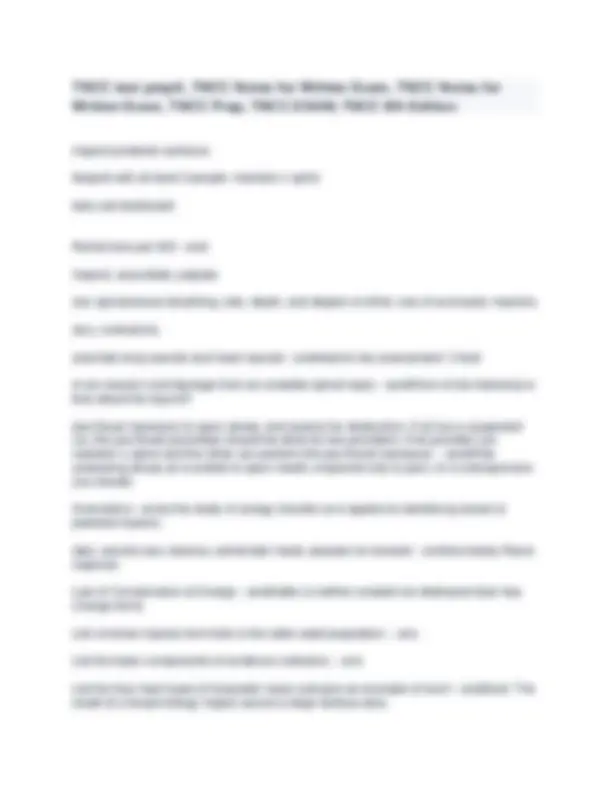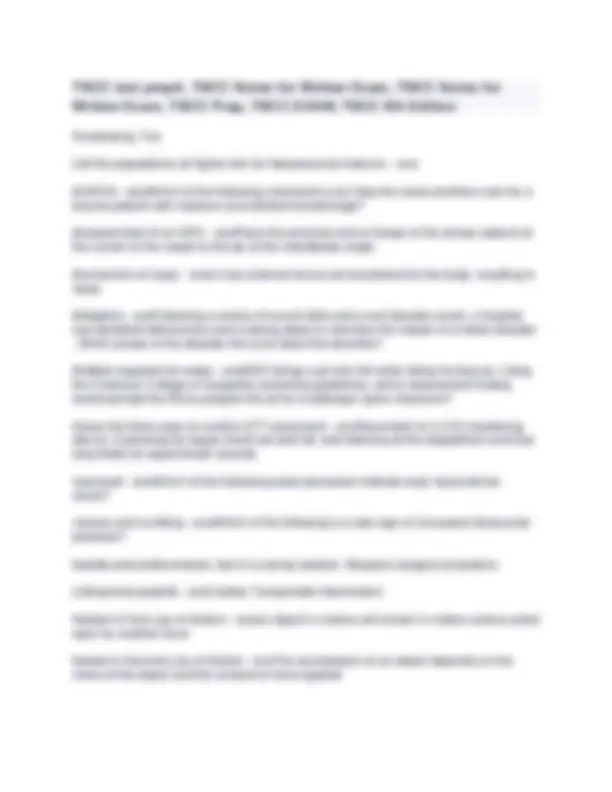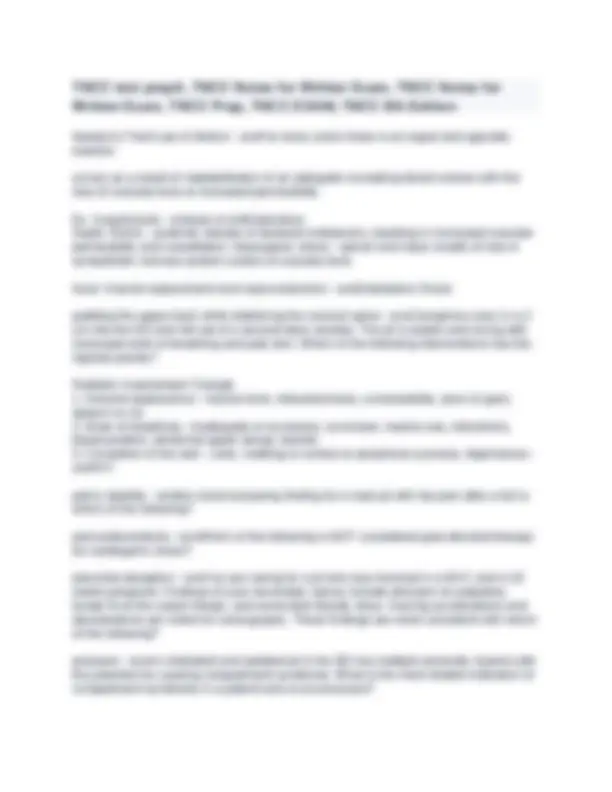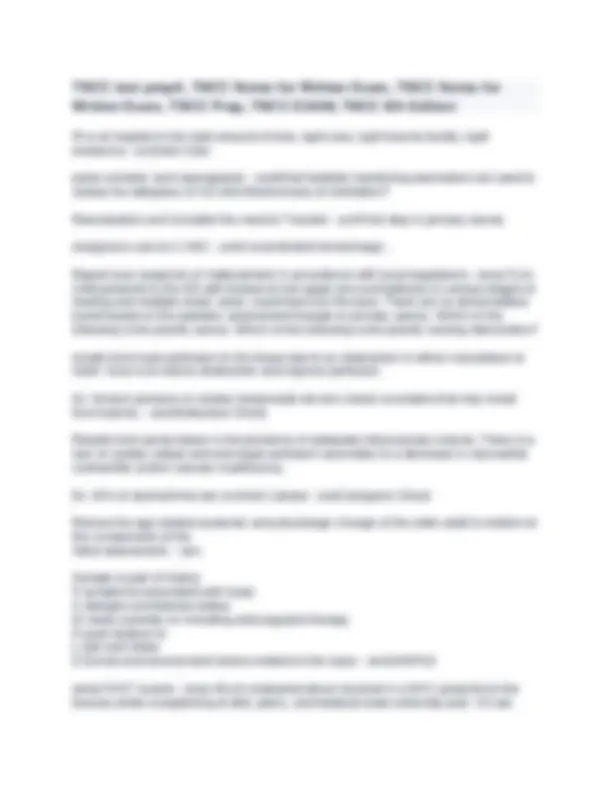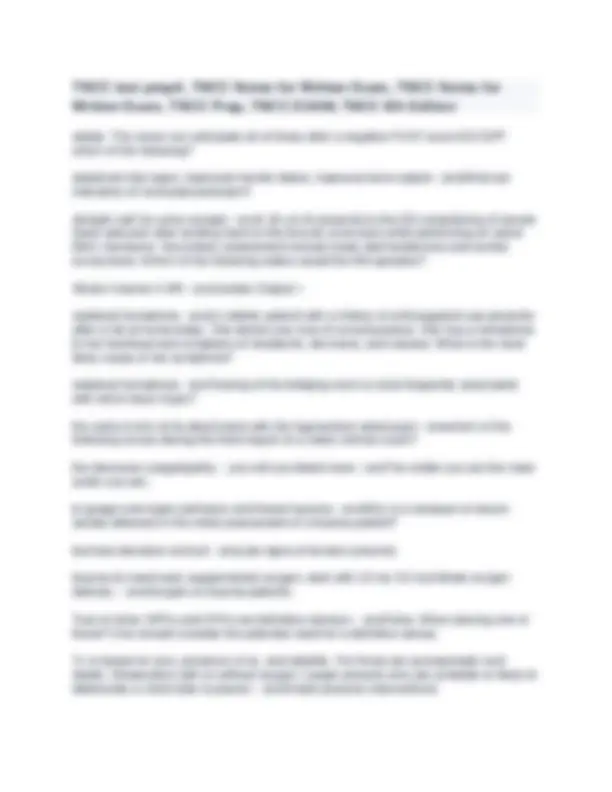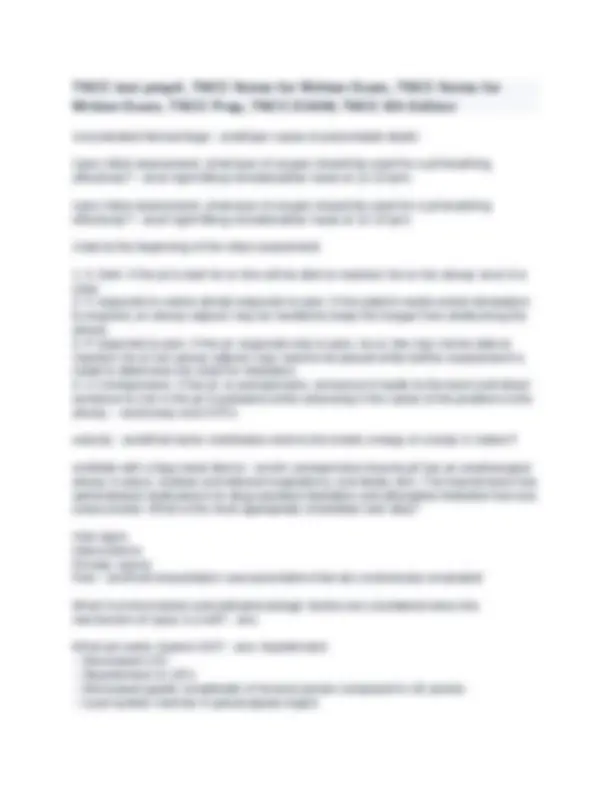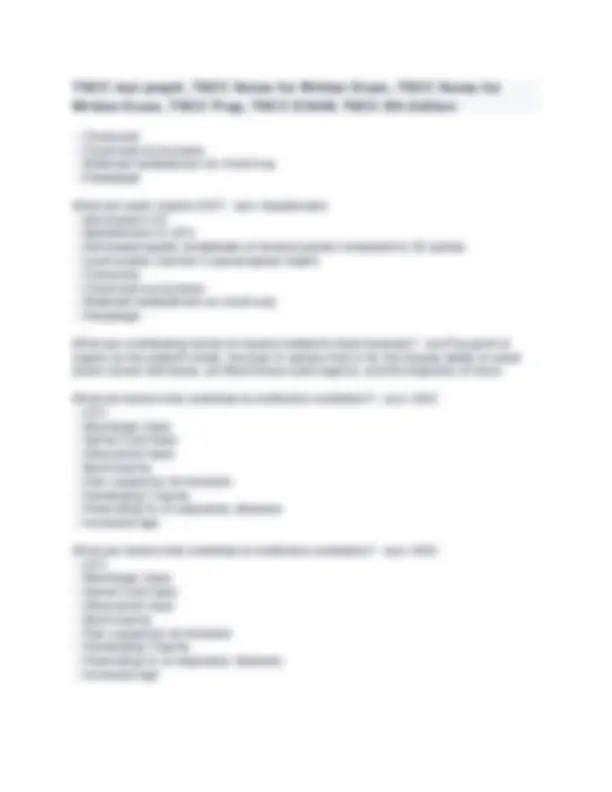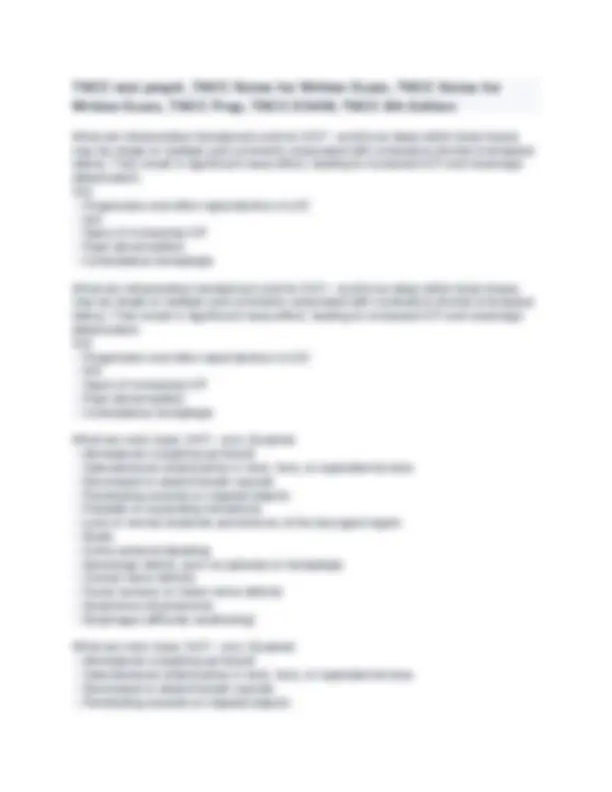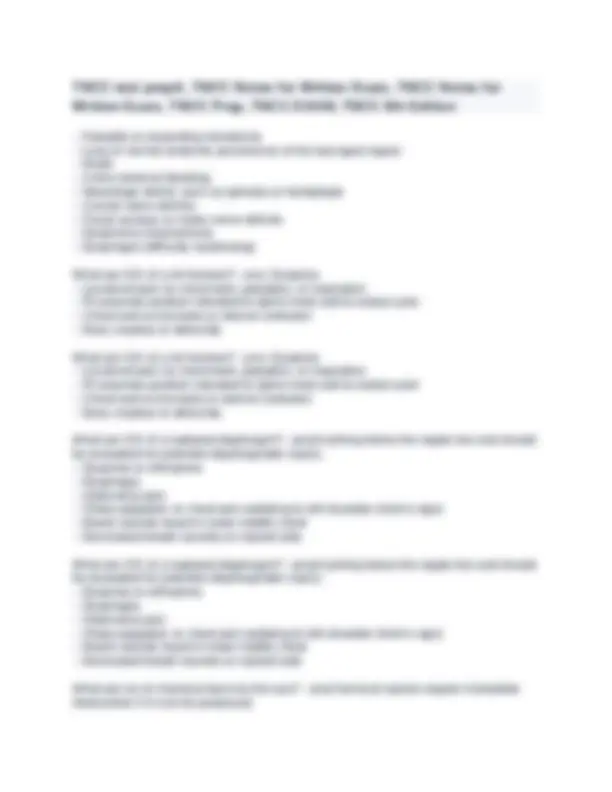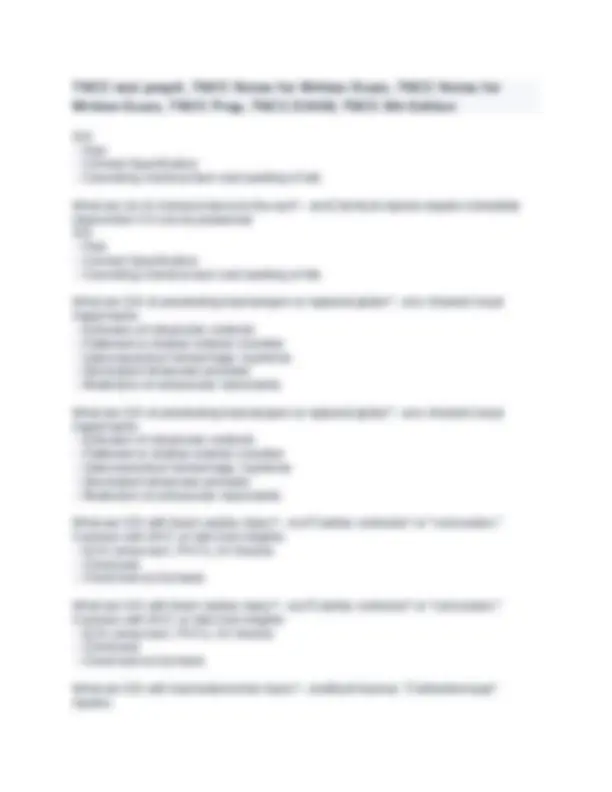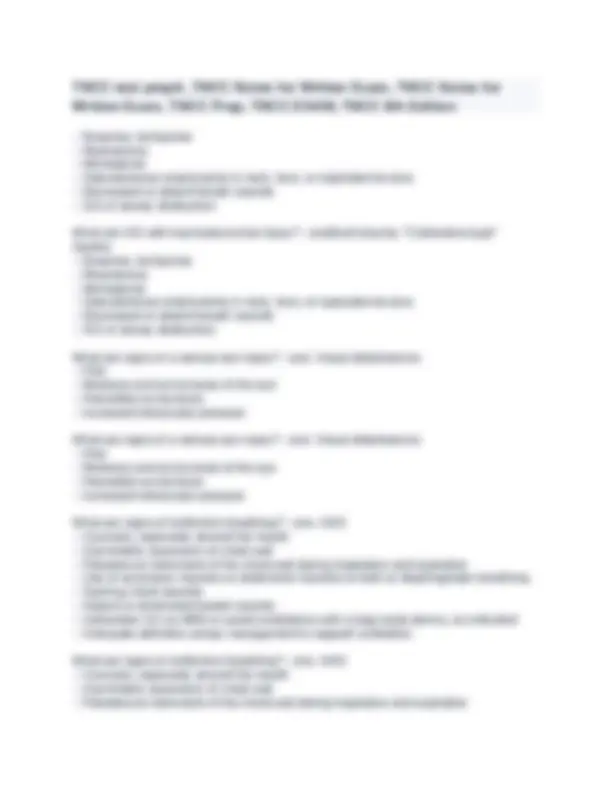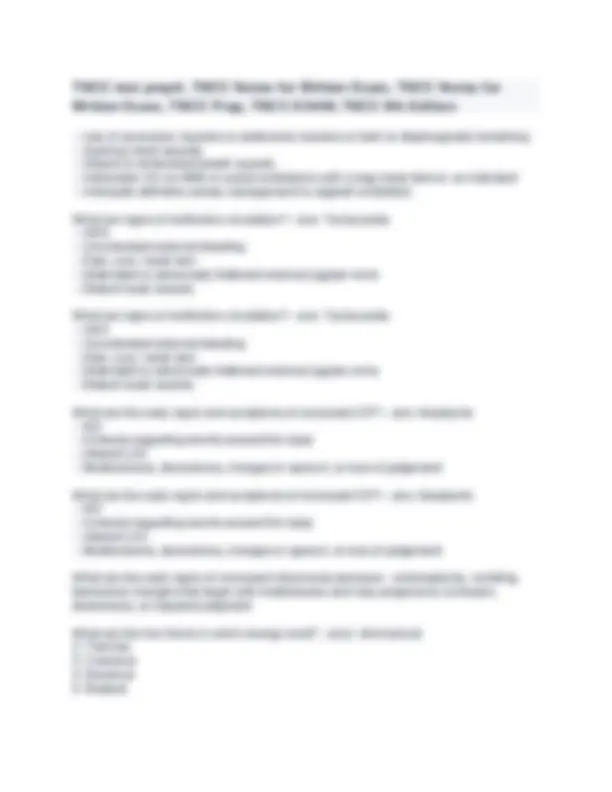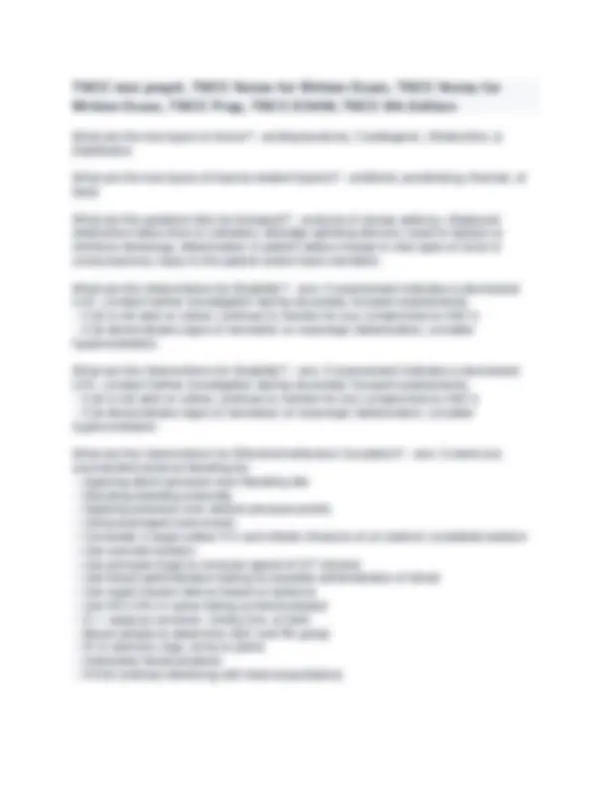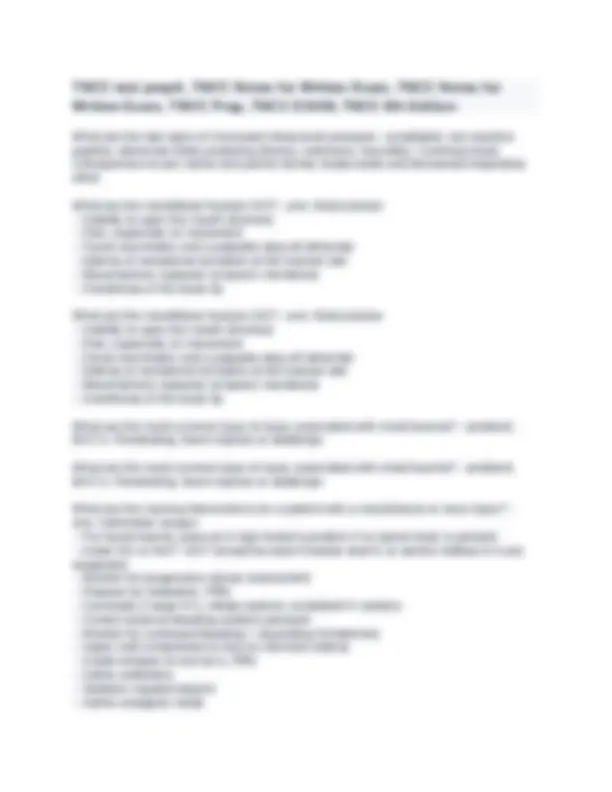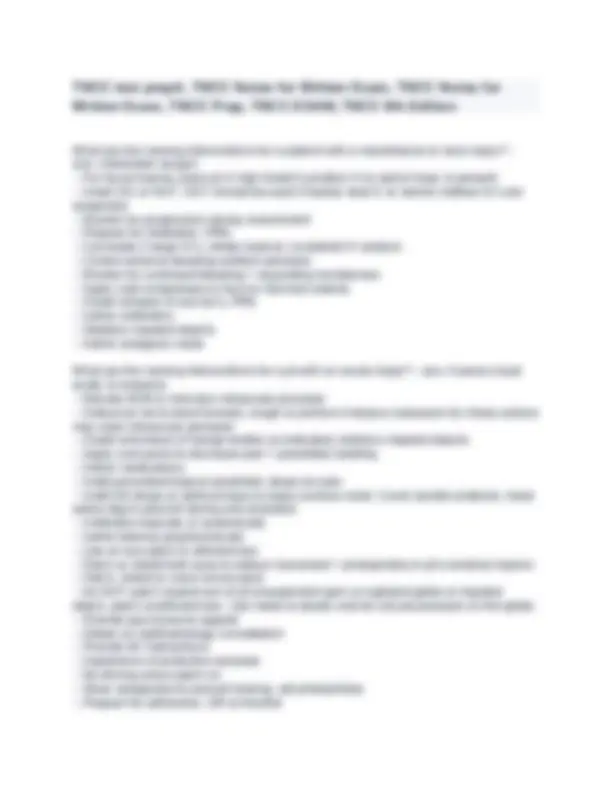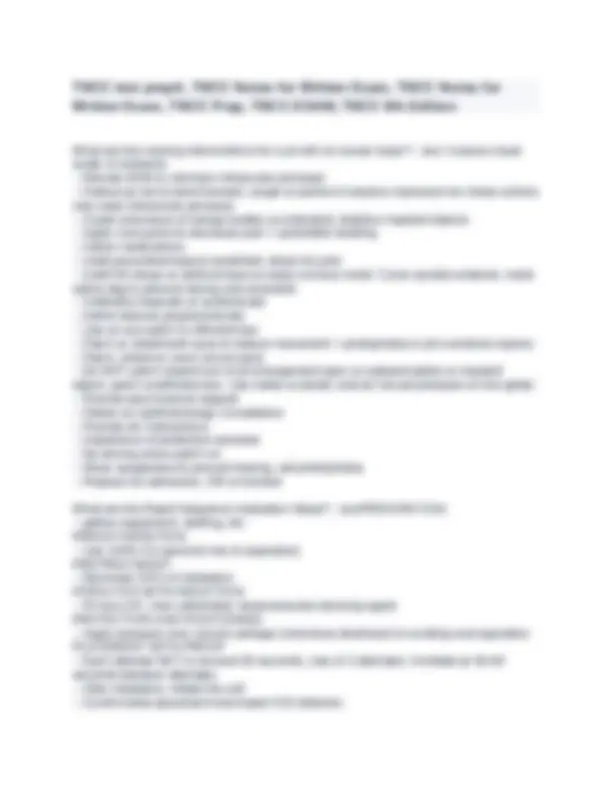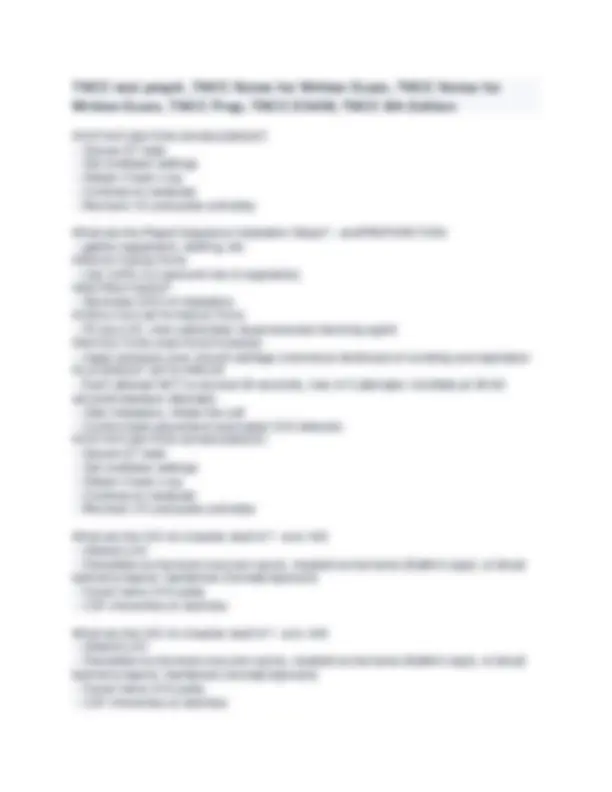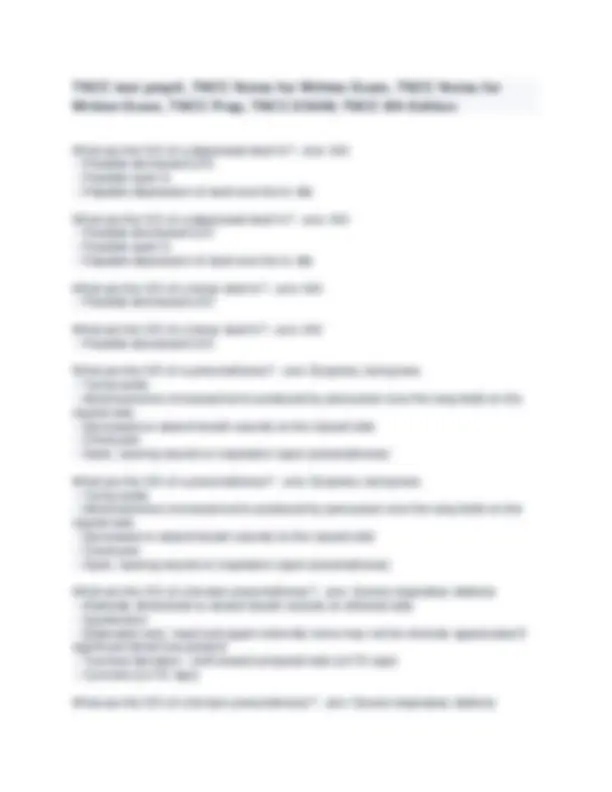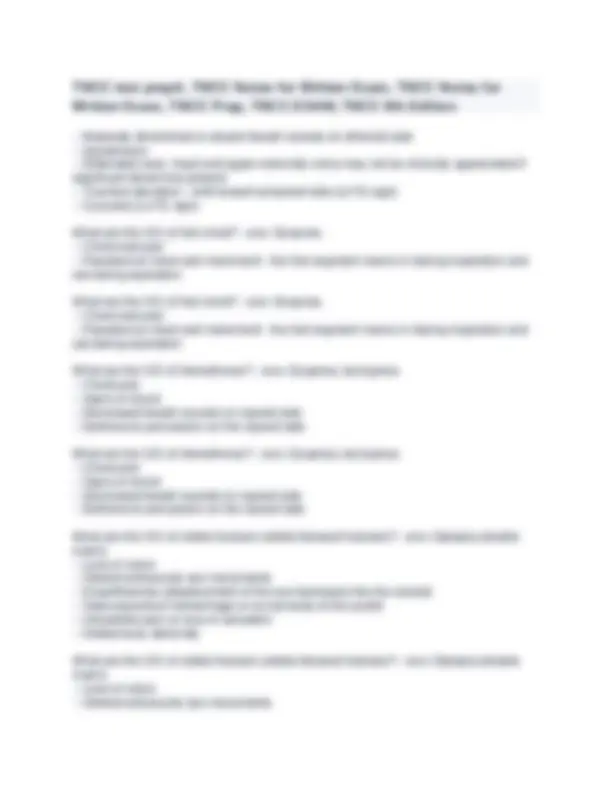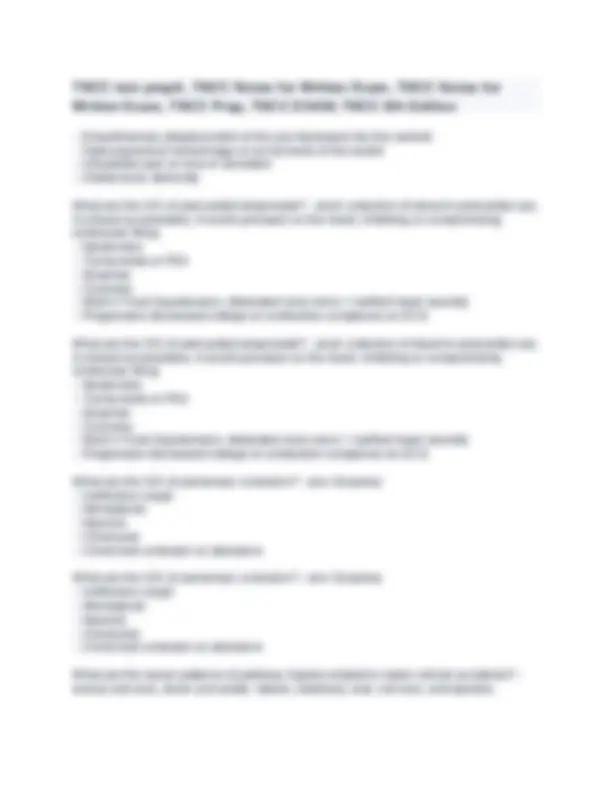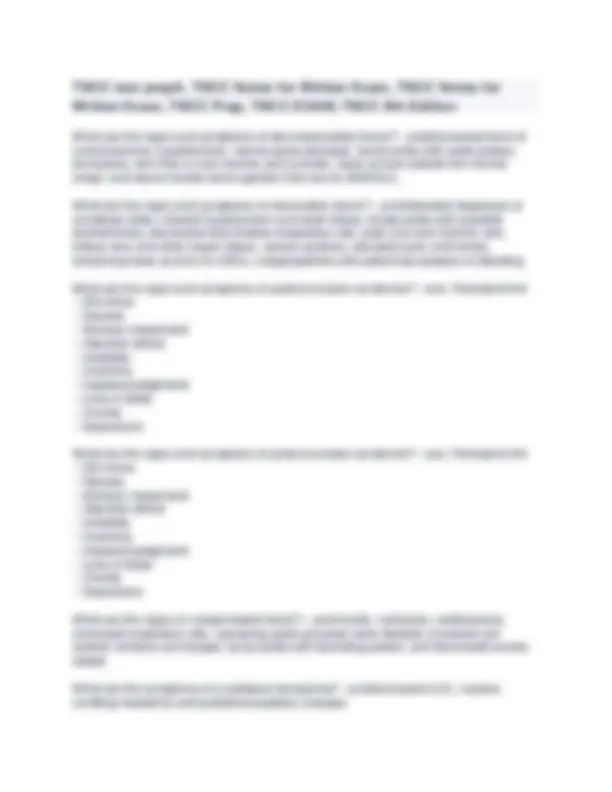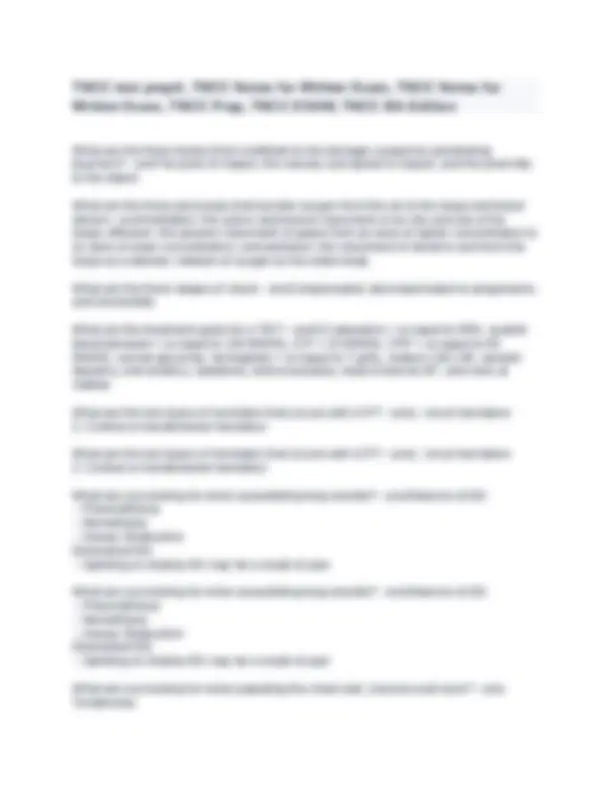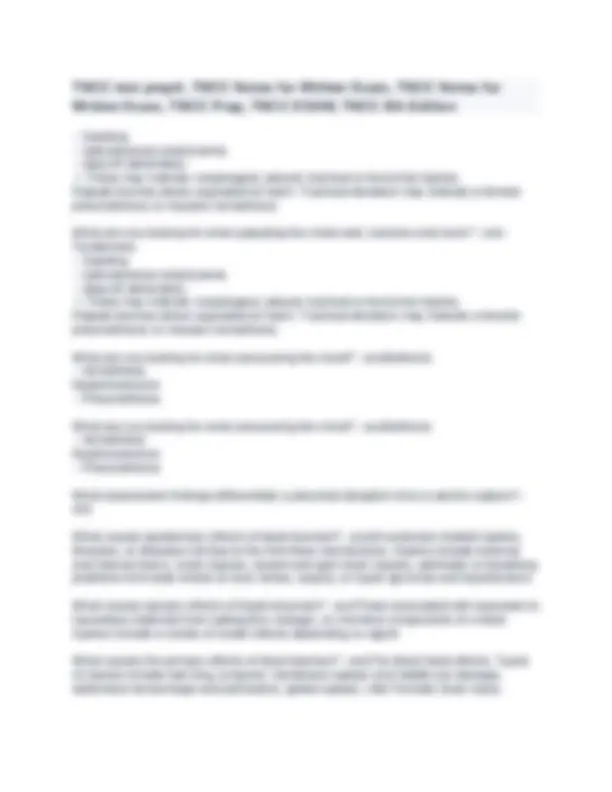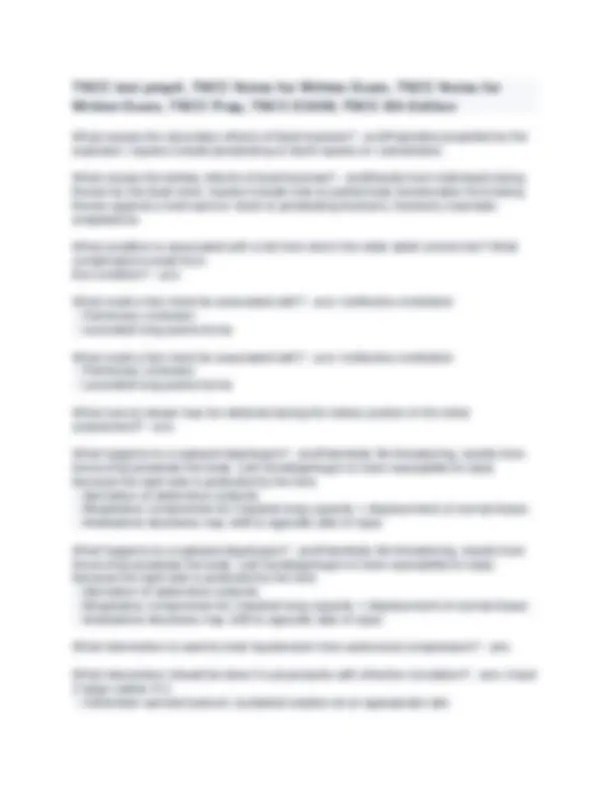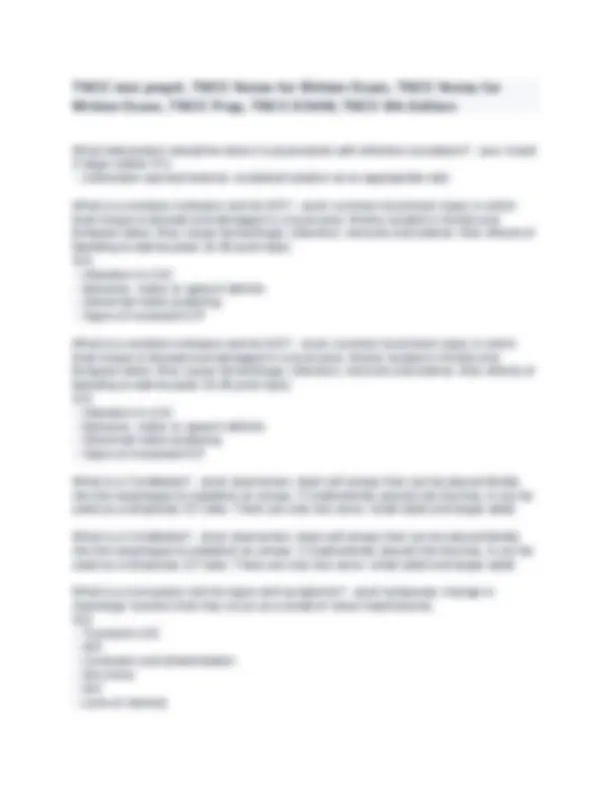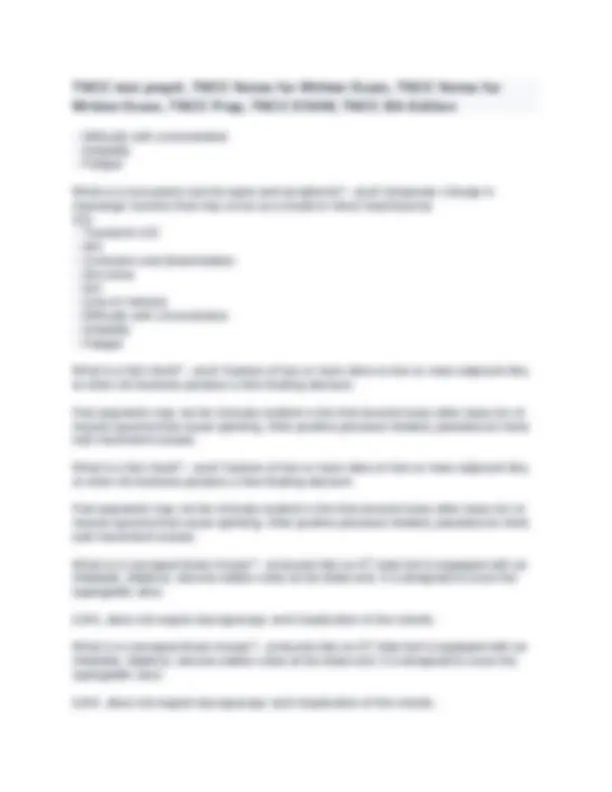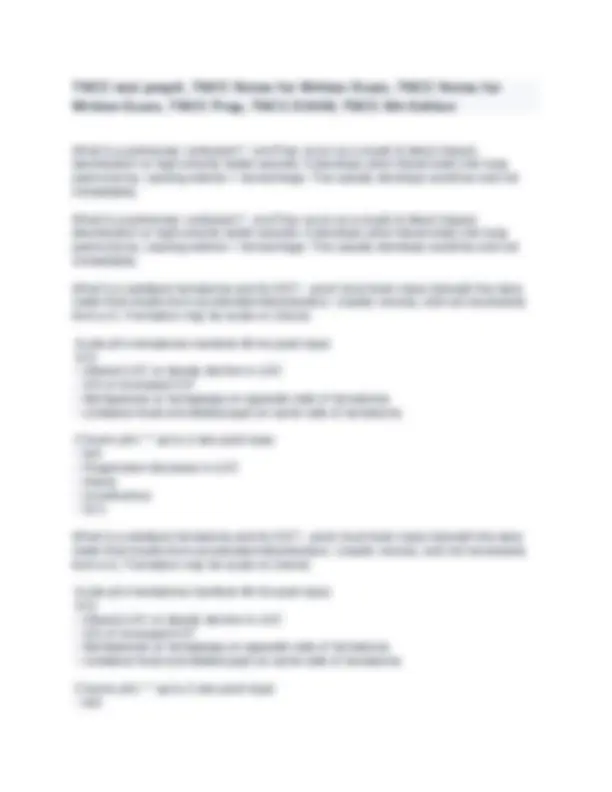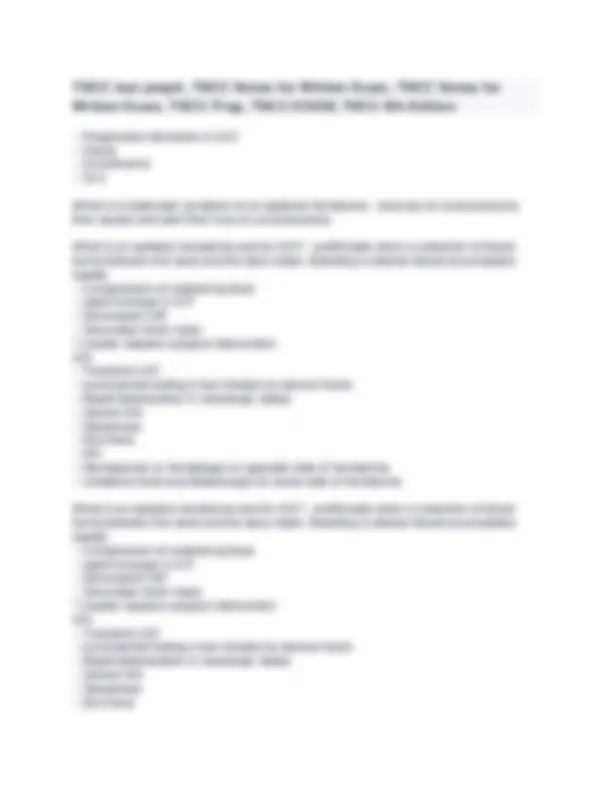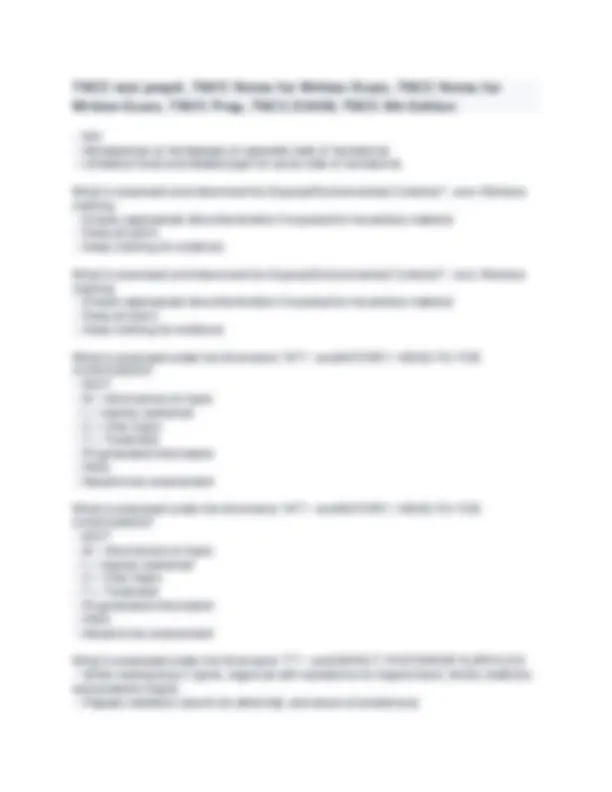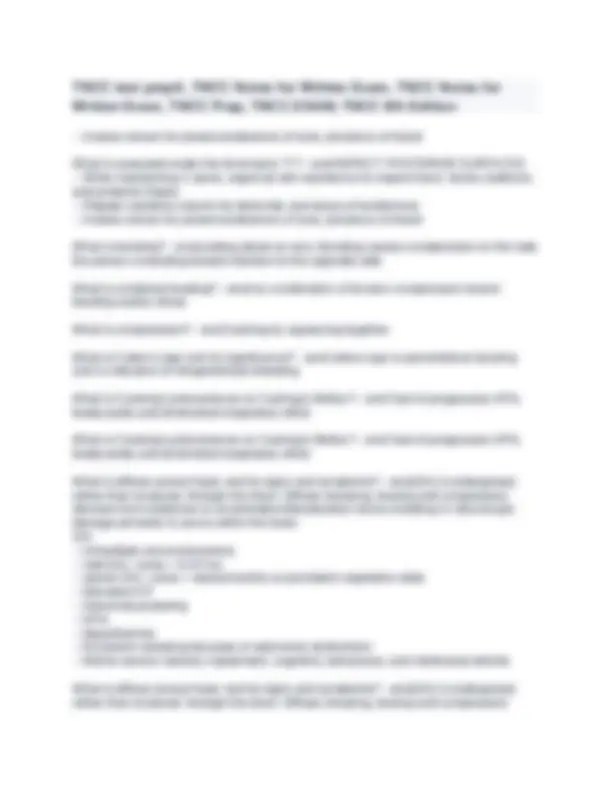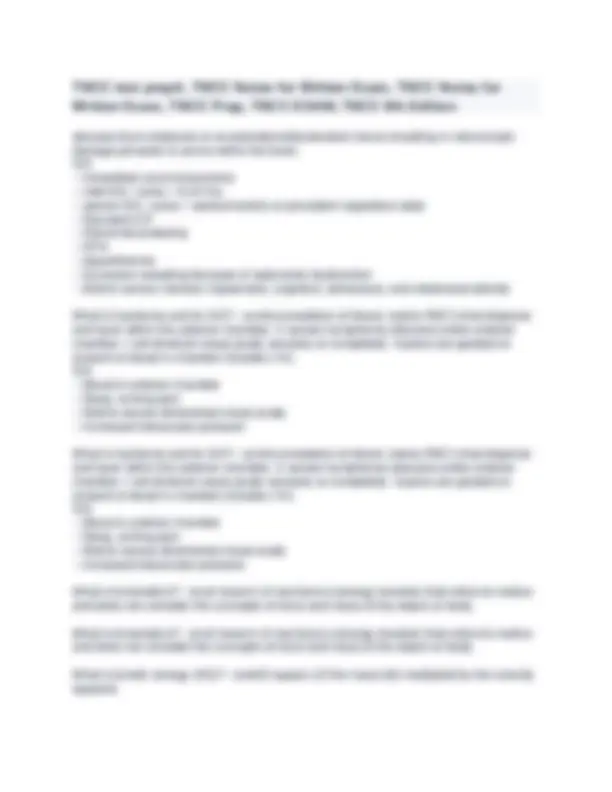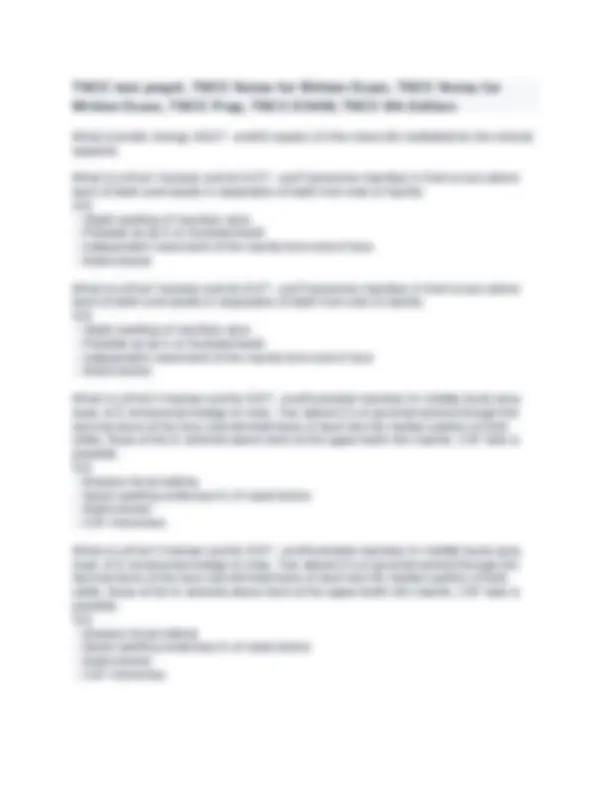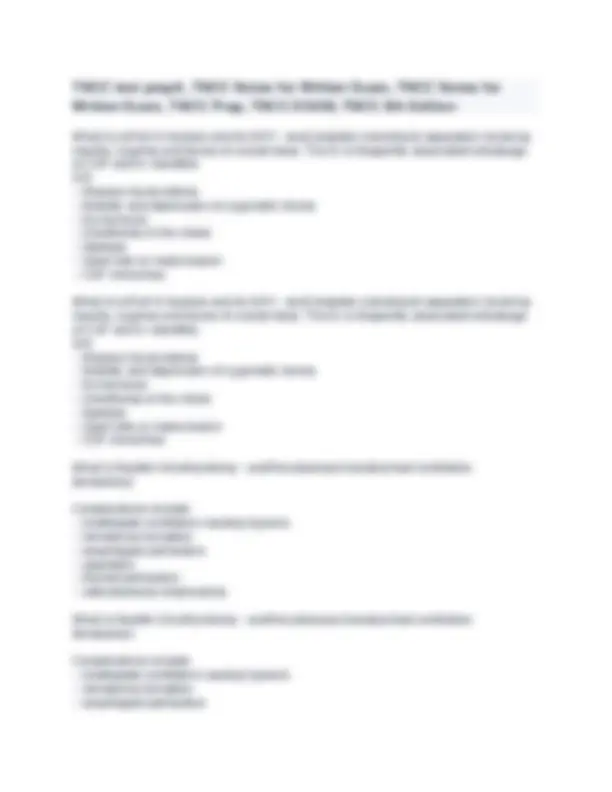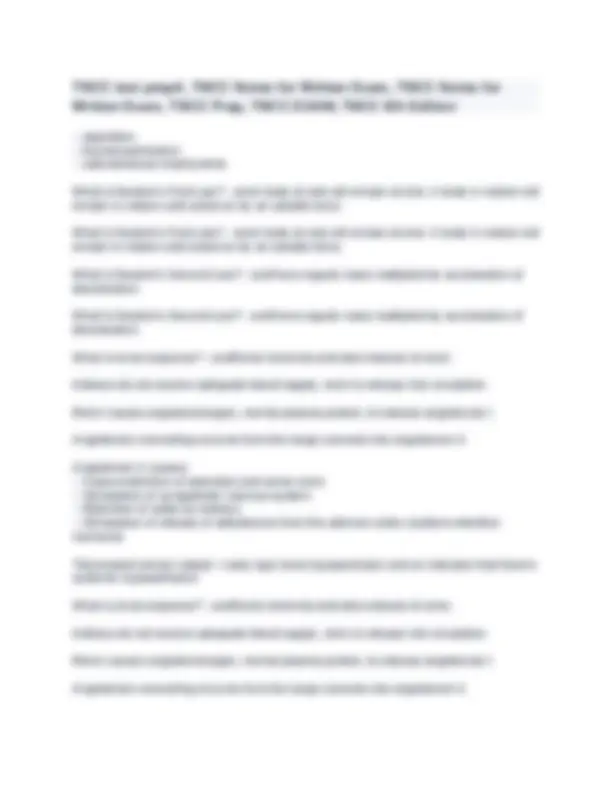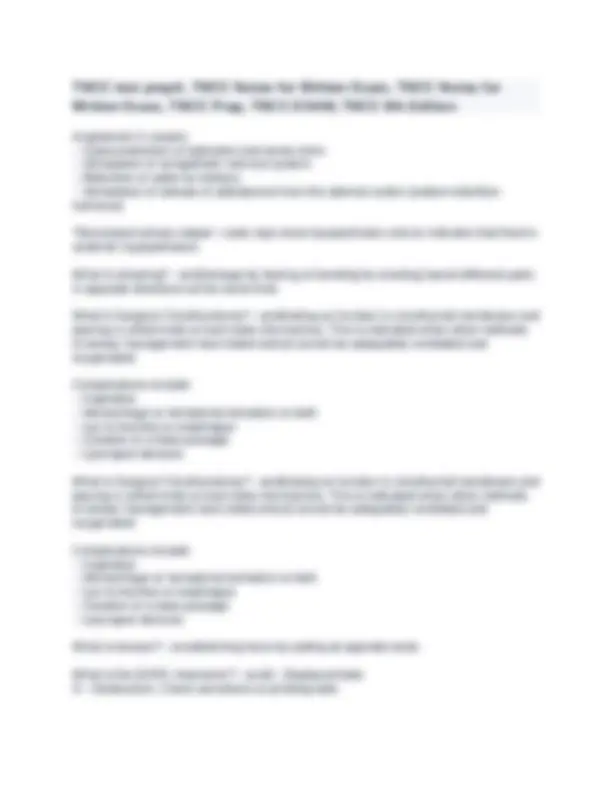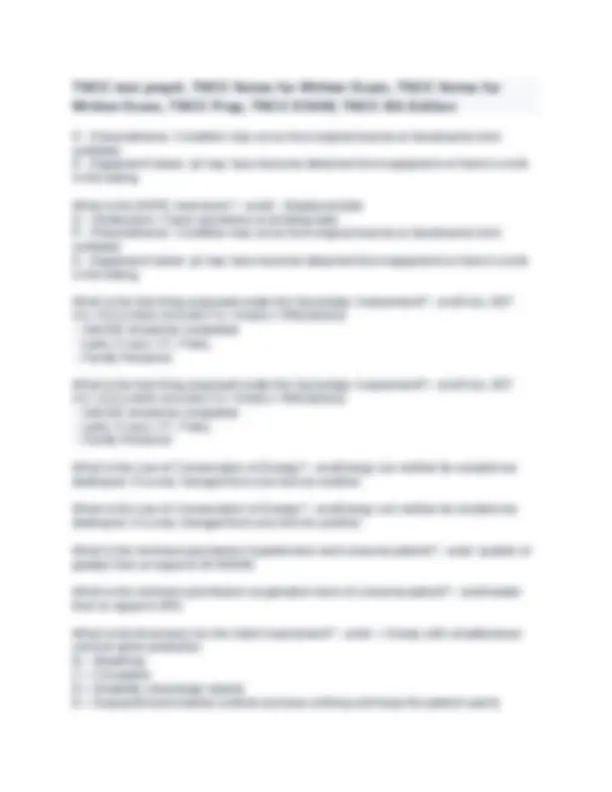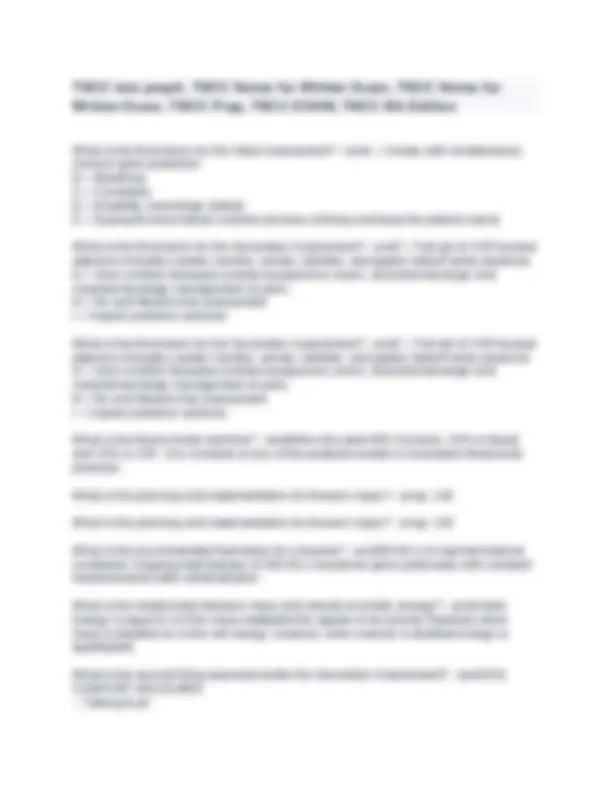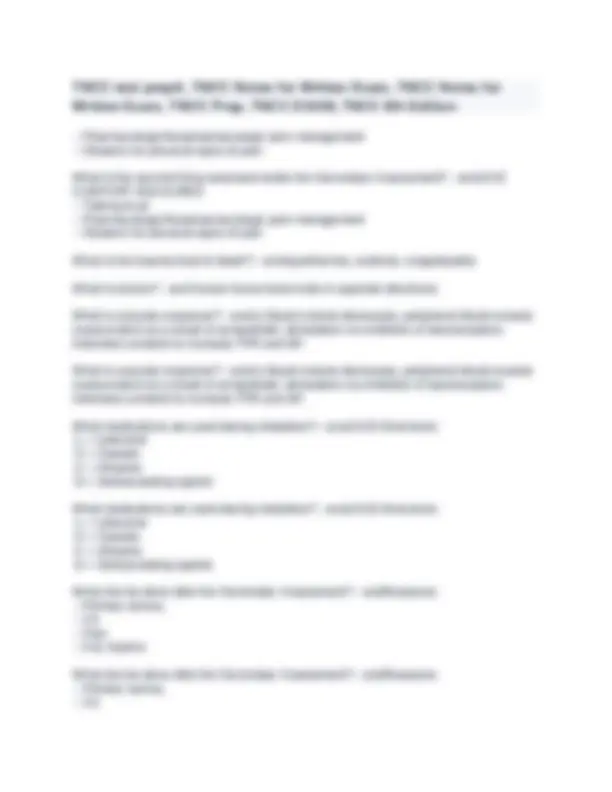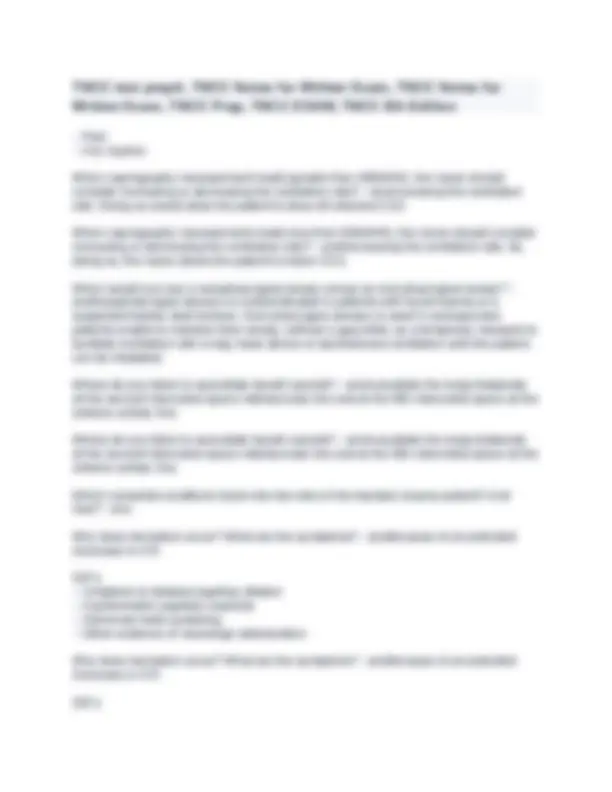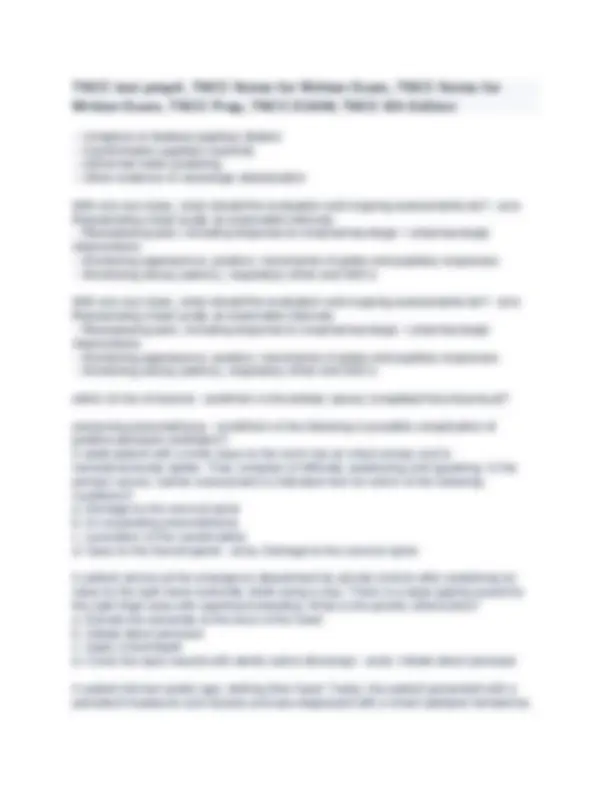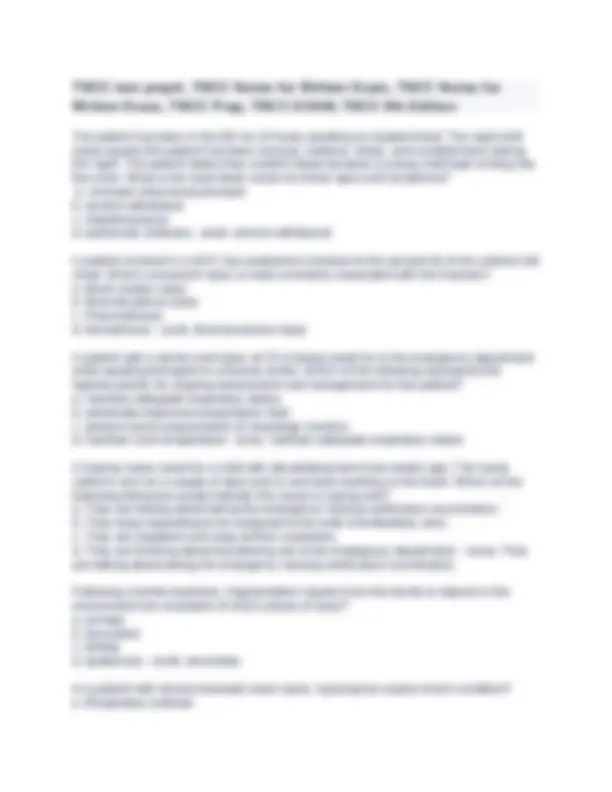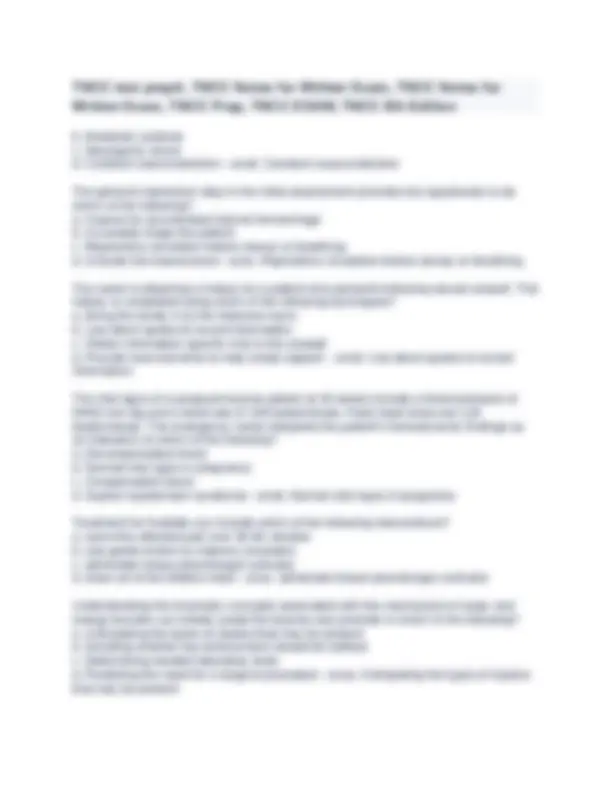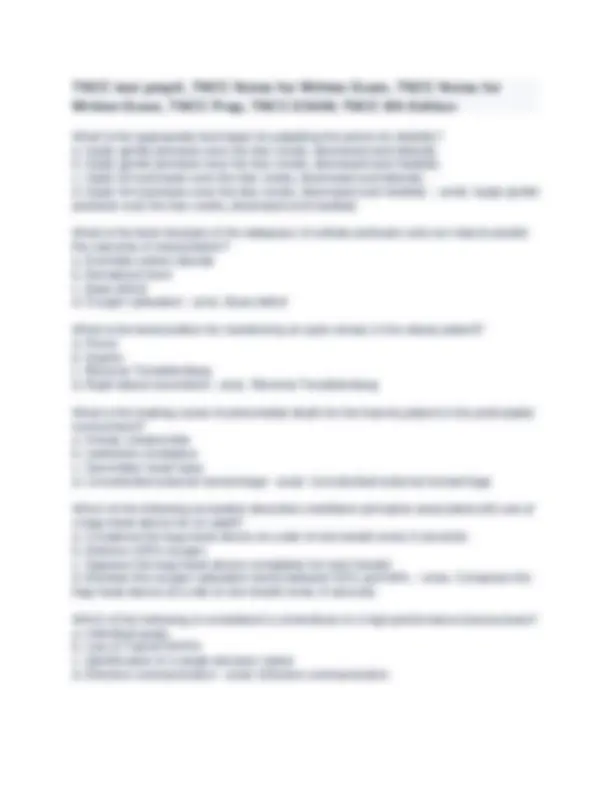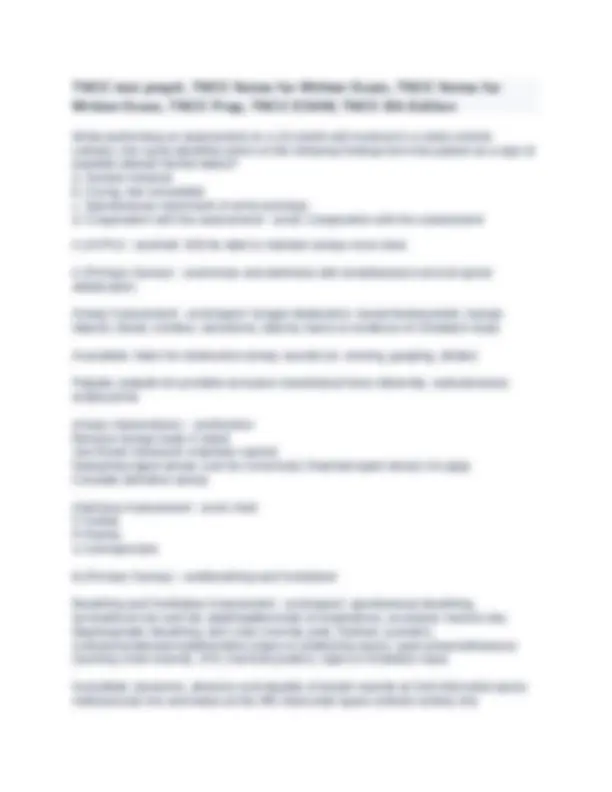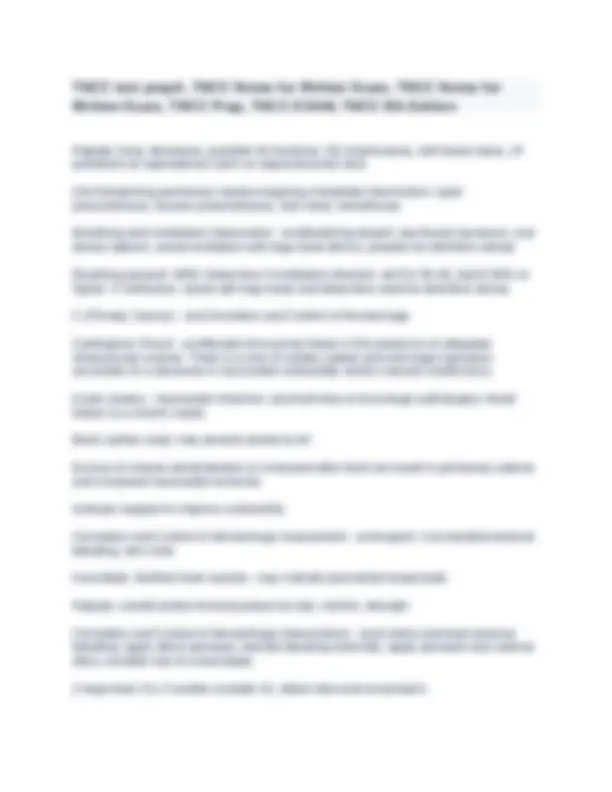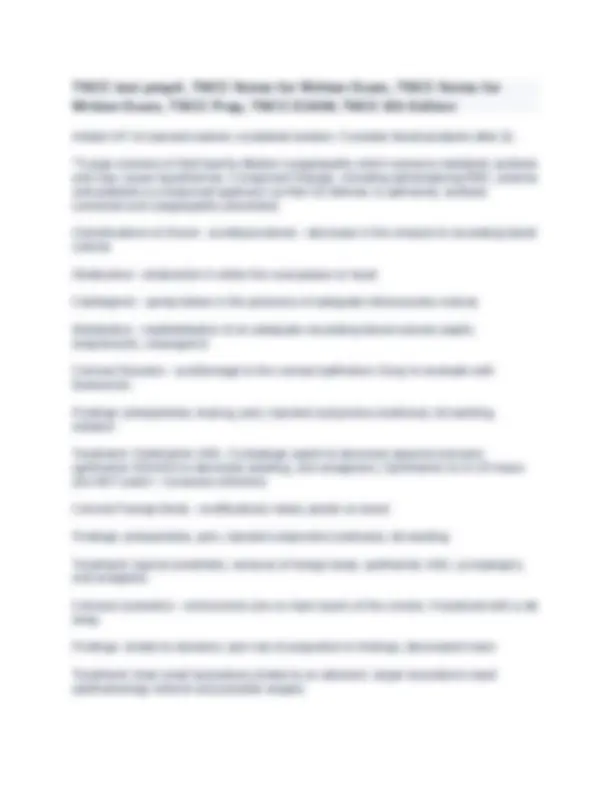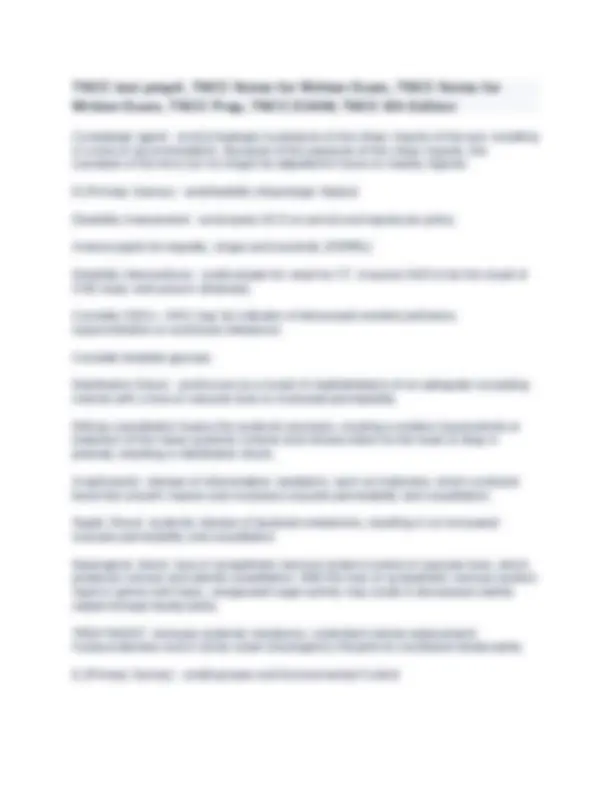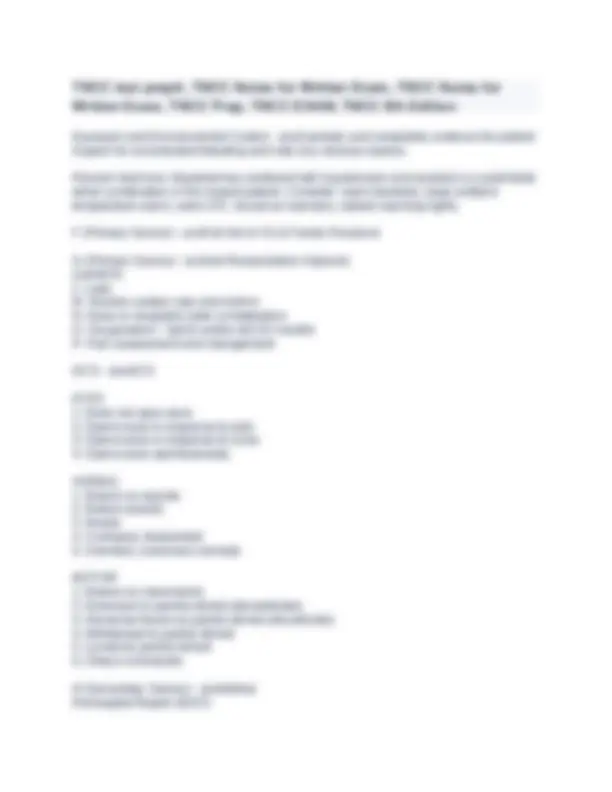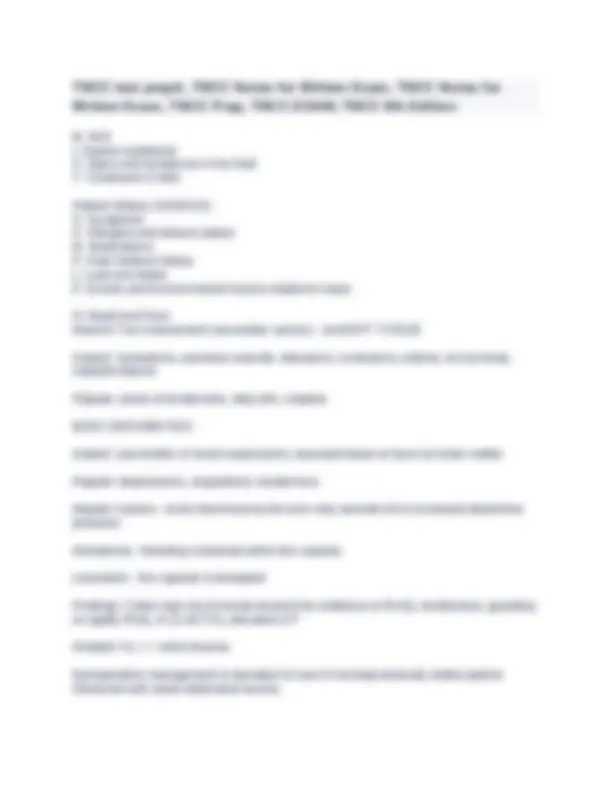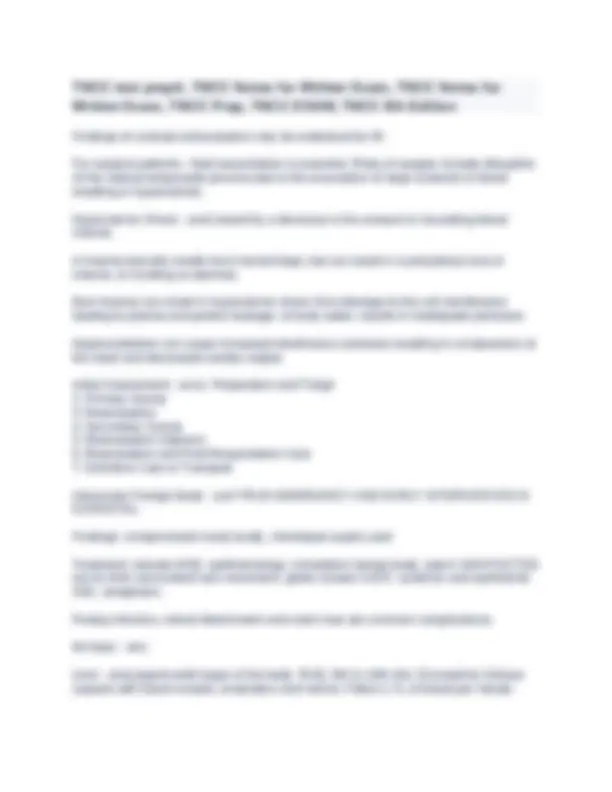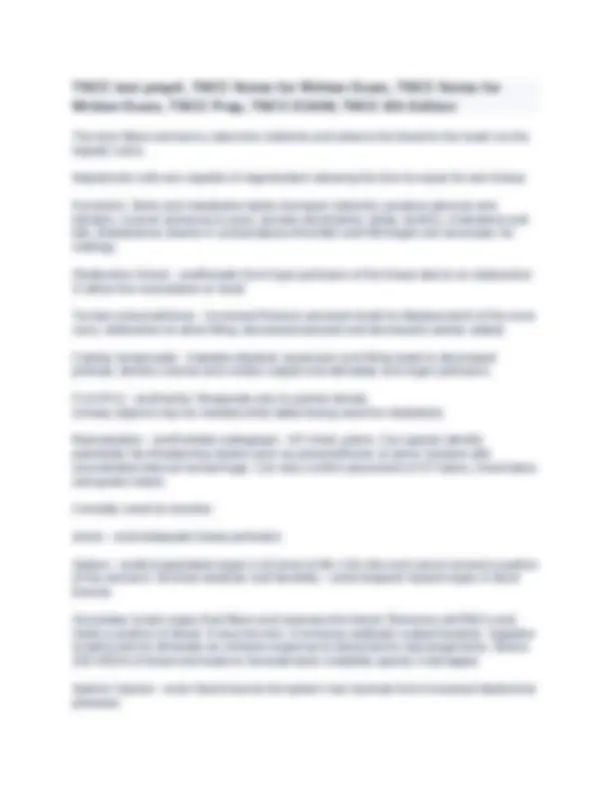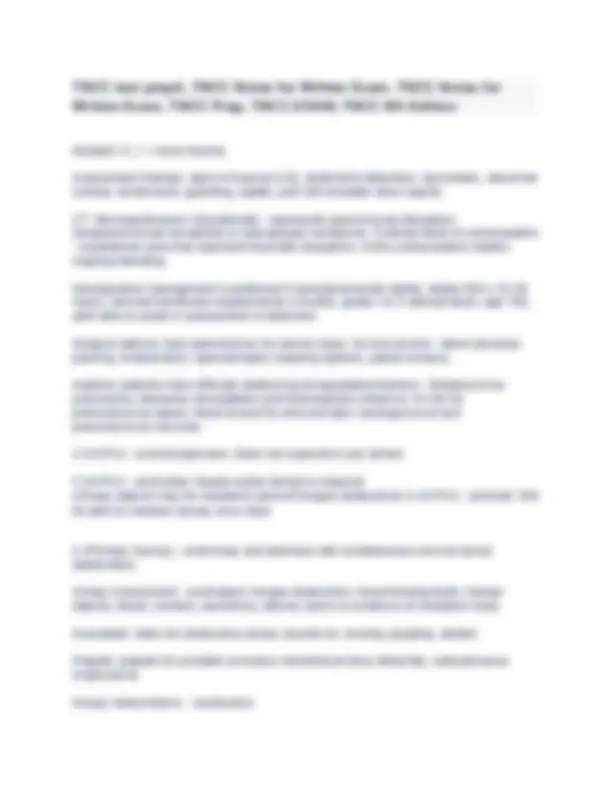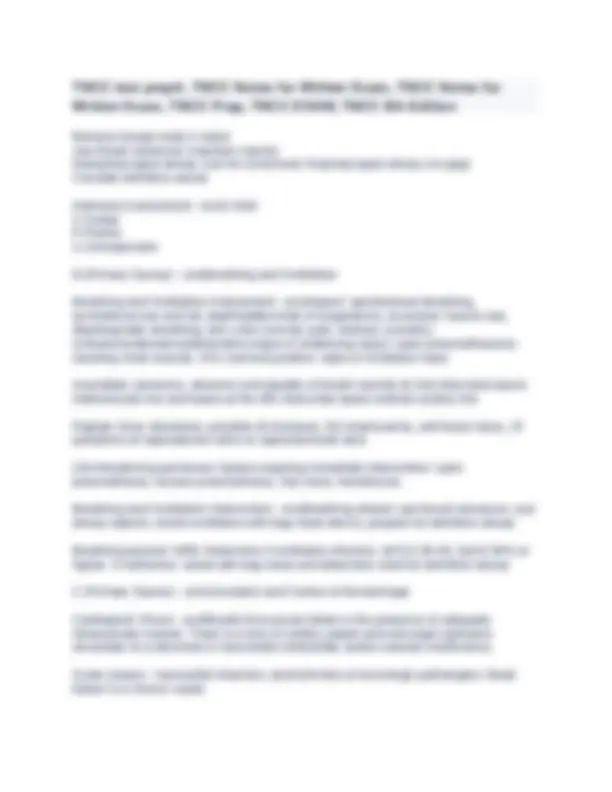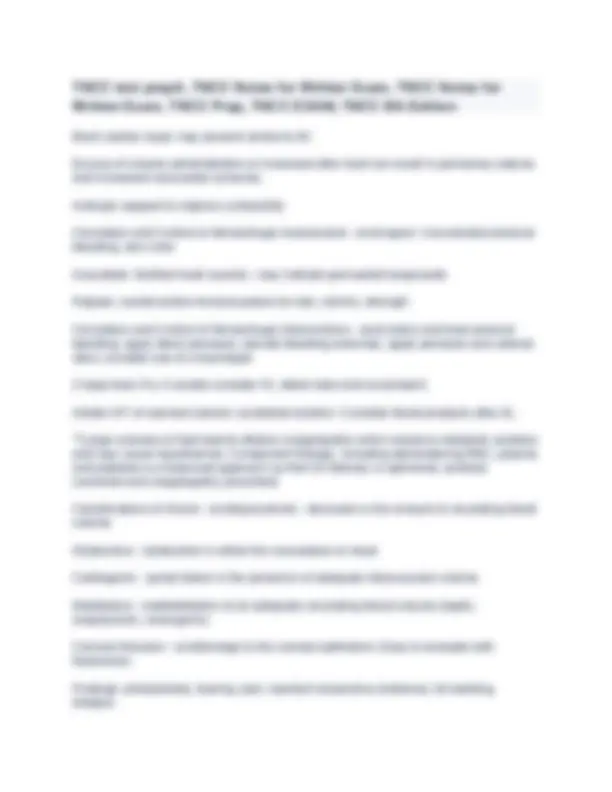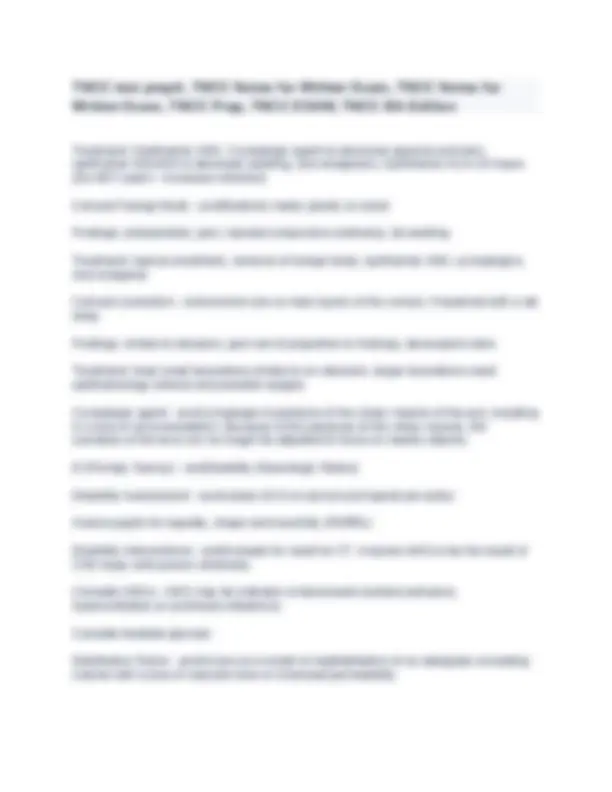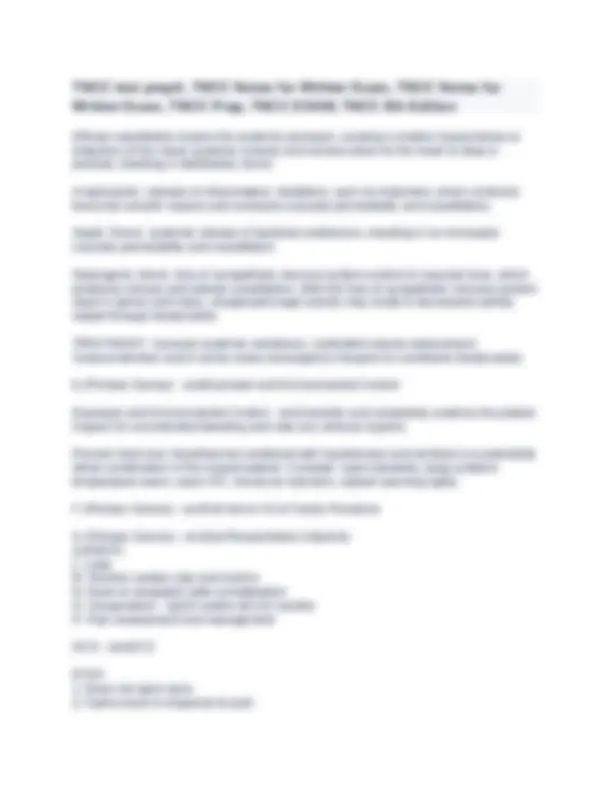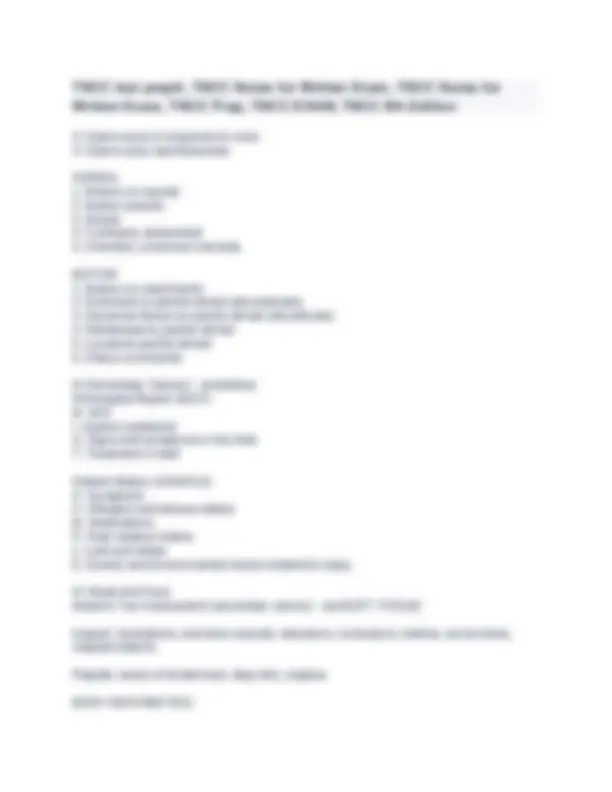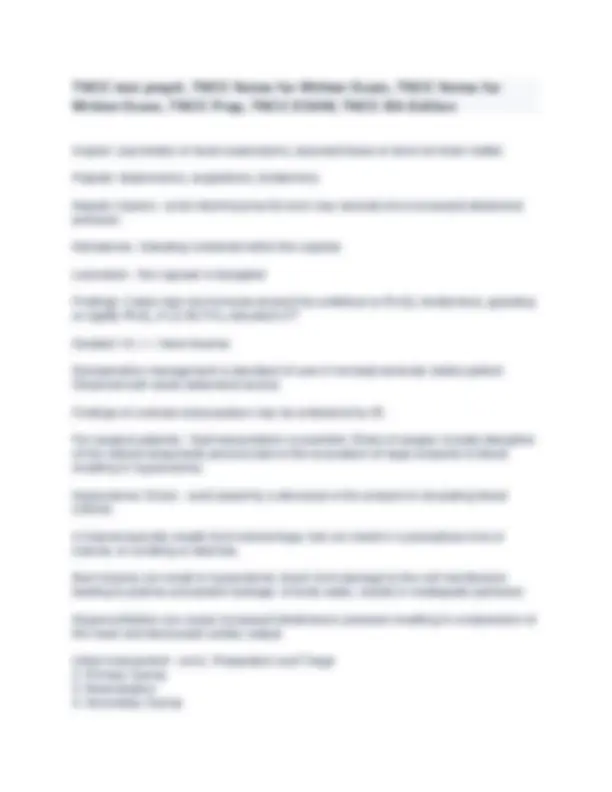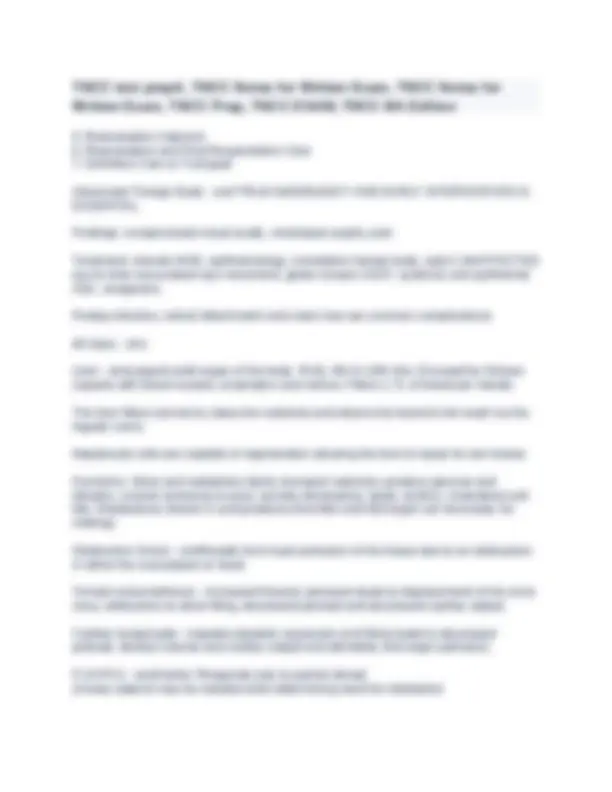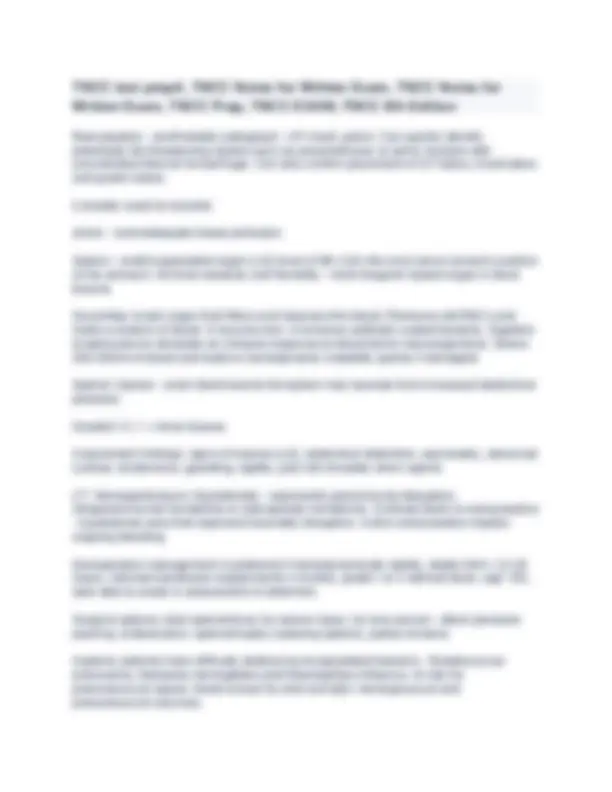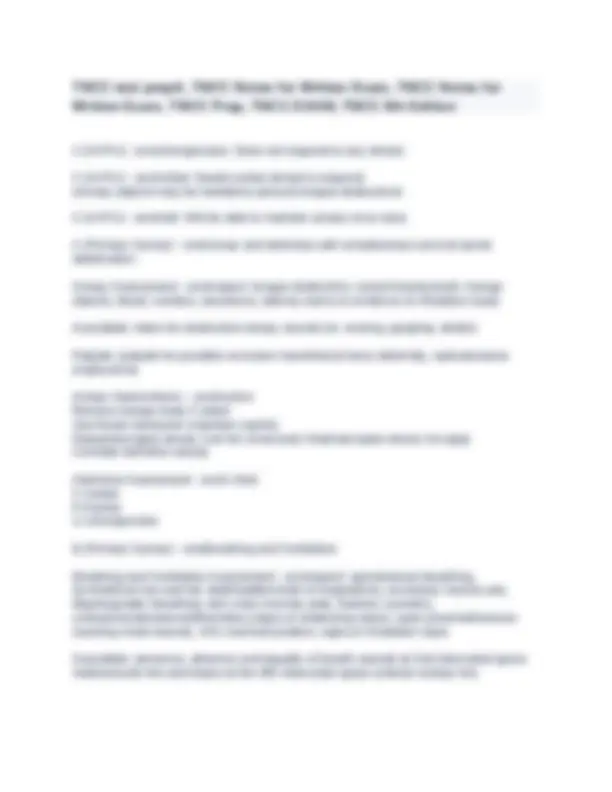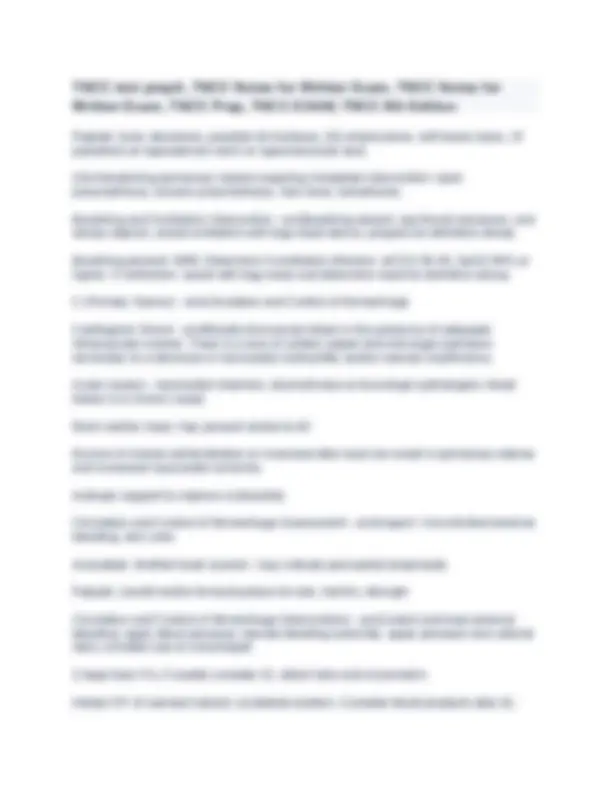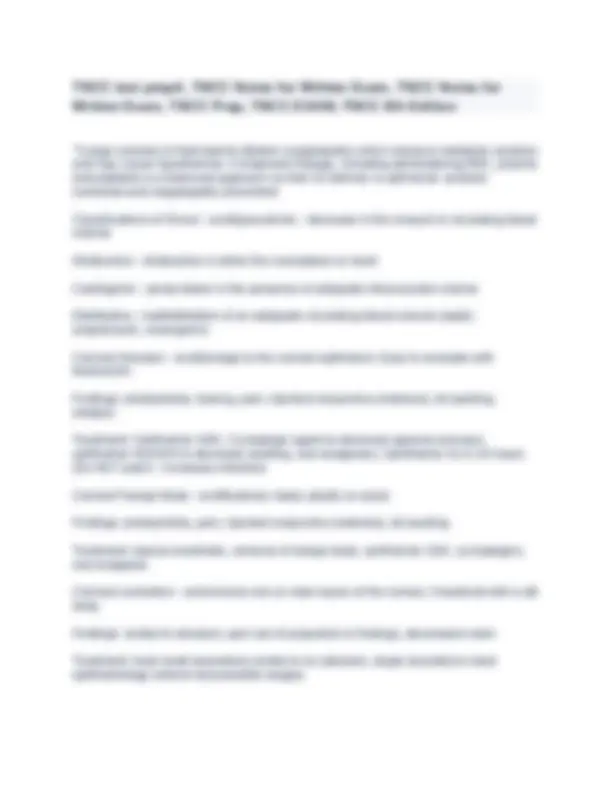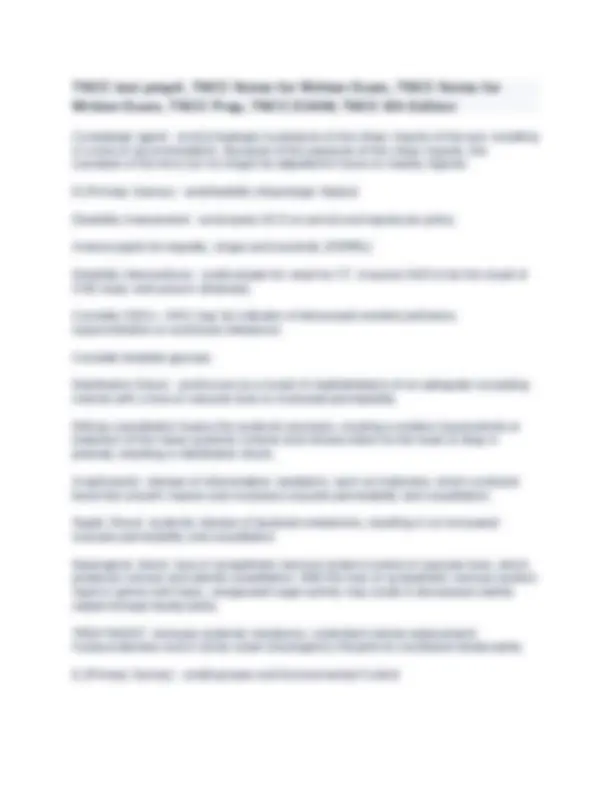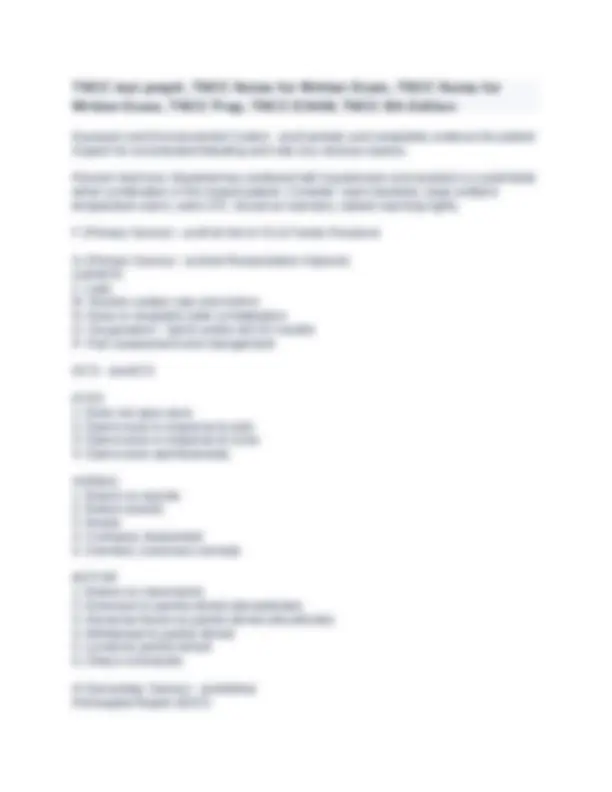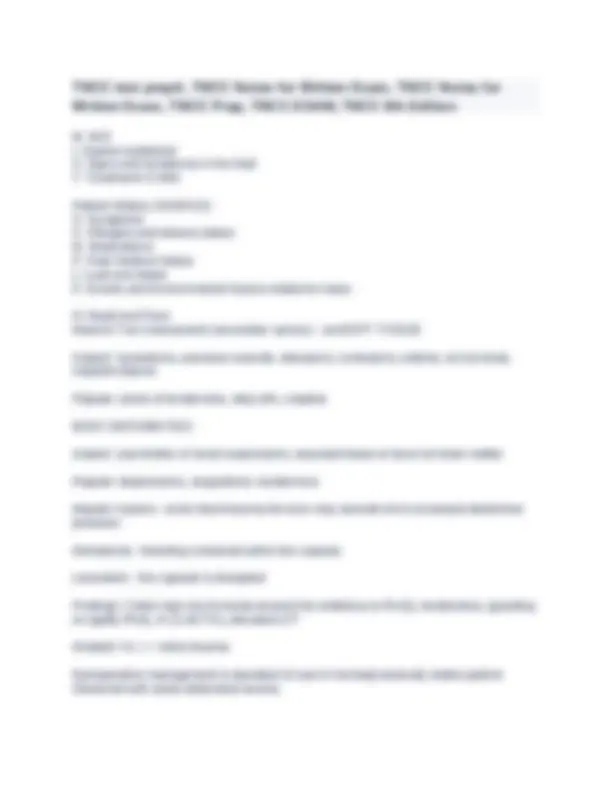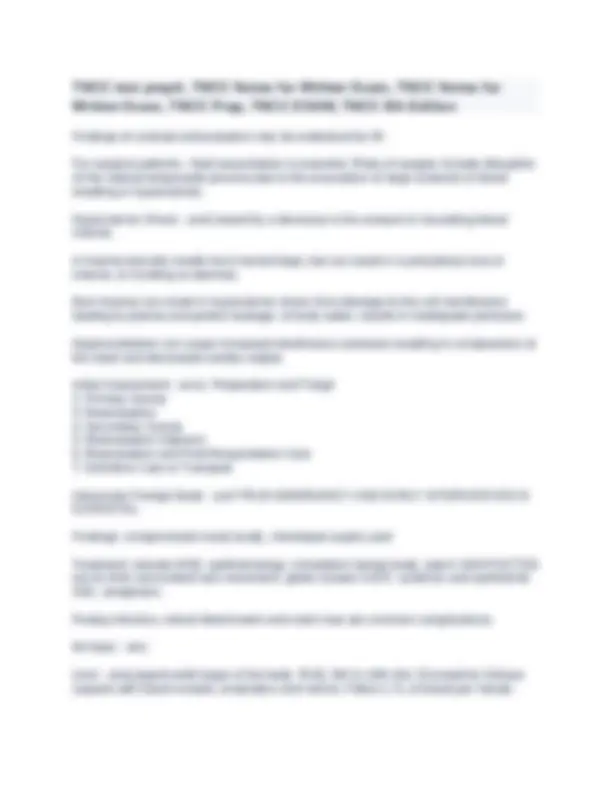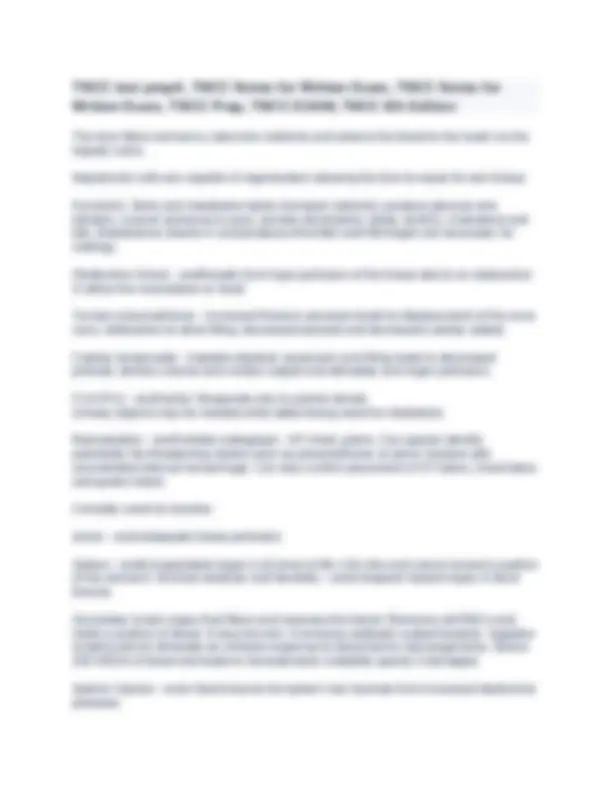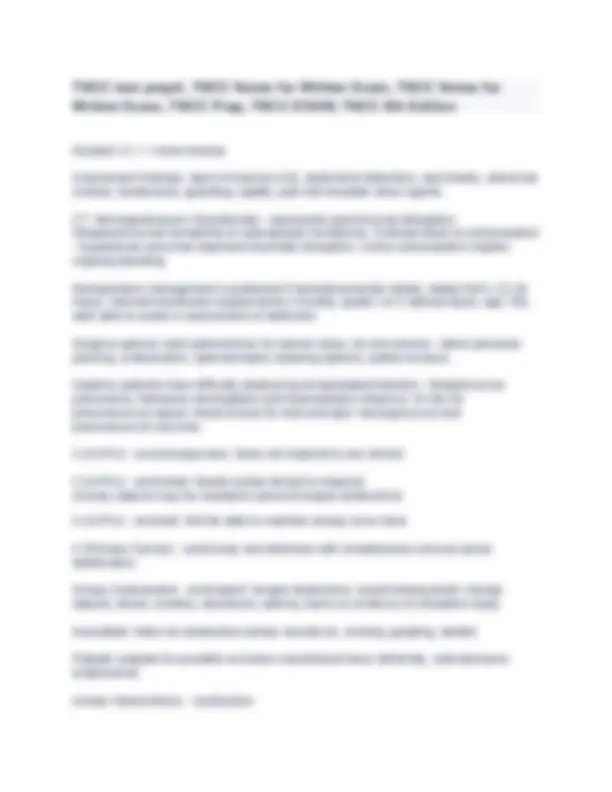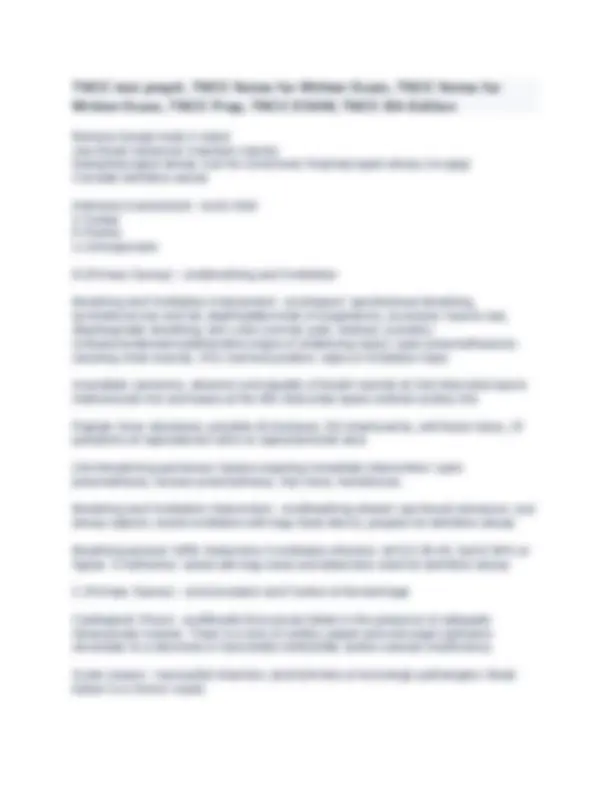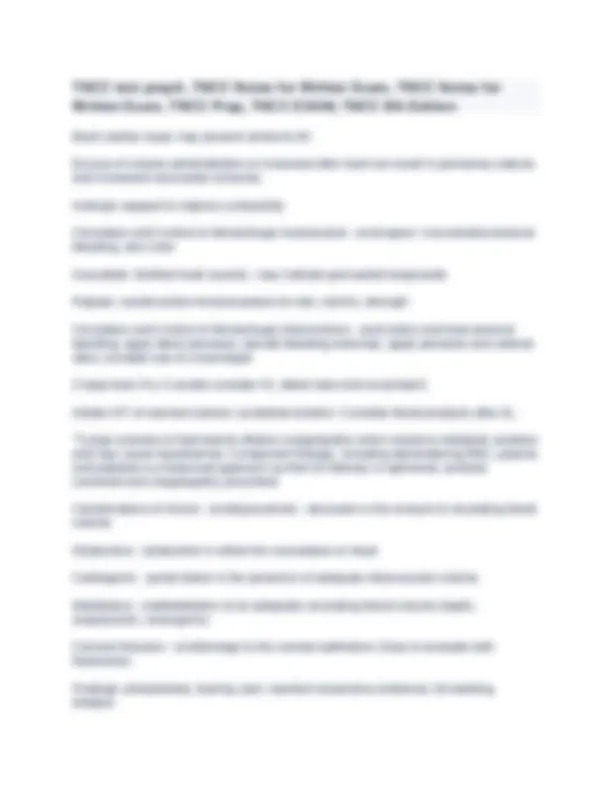Download TNCC Test Preparation Notes for Trauma Assessment and Management and more Exams Nursing in PDF only on Docsity!
Written Exam, TNCC Prep, TNCC EXAM, TNCC 8th Edition
- ansPrehospital shock index pg. 85 .. activation: .... are found in the carotid sinus and along the aortic arch, are sensitive to the degree of stretch in the arterial wall. When the receptors sense a decrease in stretch, they stimulate the sympathetic nervous system to release Epi, norepi, causing stimulation of cardiac activity and constriction of blood vessels, which causes a rise in heart rate and diastolic blood pressure - ansBaroreceptors:
- A- airway and Alertness with simultaneous cervical spinal stabilization
- B- breathing and Ventilation
- circulation and control of hemorrhage
- D - disability (neurologic status)
- F - full set of vitals and Family presence
- G - Get resuscitation adjuncts L- Lab results (arterial gases, blood type and crossmatch) M- monitor for continuous cardiac rhythm and rate assessment N- naso or orogastric tube consideration O- oxygenation and ventilation analysis: Pulse oxygemetry and end-tidal caron dioxide (ETC02) monitoring and capnopgraphy H- History and head to toe assessment I- Inspect posterior surfaces - ansABCDEFGHI
- Apnea
- GCS 8 or less
- Maxillary fractures
- Evidence of inhalation injury (facial burns)
- Laryngeal or tracheal injury or neck hematoma
- High risk of aspiration and patients inability to protect the airway
- Compromised or ineffective ventilation - ansFollowing conditions might require a definitive airway
- bony fractures and possible rib fractures, which may impact ventilation
- palpate for crepitus
- subcutaneous emphysema which may be a sign for a pneumothorax
- soft tissue injury - ansPalpate the chest for
- Check the presence of adequate rise and fall of the chest with assisted ventilation
- Absence of gurgling on auscultation over the epigastrium
- Bilateral breath sounds present on auscultation
- Presence of carbon dioxide (CO2) verified by a CO2 device or monitor - ansIf the pt has a definitive airway in what should you do?
Written Exam, TNCC Prep, TNCC EXAM, TNCC 8th Edition
- Dyspnea
- Tachycardia
- Decreased or absent breath sounds on the injured side
- CP - ansSimple Pneumo assessment:
- equal breath sounds bilaterally at the second intercostal space midclavicular line and the bases for fifth intercostal space at the axillary line - ansAuscultate the chest for:
- Get a CT
- Consider ABG 's if decreased LOC
- Consider glucose check - ansD Interventions
- Hypotension
- JVD
- Muffled heart sounds - ansBecks Triad:
- open the airway, use jaw thrust
- insert an oral airway
- assist ventilations with a bag mask
- prepare for definitive airway - ansIf breathing is absent..
- pain - hallmark sign, early sign
- pressure - early sign
- pallor, pules, paresthesia, paralysis - late sign - ansSix P's of compartment syndrome:
- Preparation
- Preoxygenation
- Pretreatment
- Paralysis and Induction
- Protecting and positioning - v
- Placement of proof - secure the tube
- Post intubation - secure ETT Tube, get X-ray for placement - ansSteps of Rapid Sequence Intubation
- Preparation and Triage
- Primary Survery (ABCDE) with resuscitation adjuncts (F,G)
- Reevaluation (consideration of transfer)
- Secondary Survey (HI) with reevaluation adjuncts
- Reevaluation and post resuscitation care
- Definitive care of transfer to an appropriate trauma nurse - ansInitial Assessment
Written Exam, TNCC Prep, TNCC EXAM, TNCC 8th Edition
activation: consist of carotid and aortic bodies. ... detect changes in blood oxygen and Co2 and pH. When Co2 rises or oxygen level of pH falls these receptors are activated and information is relayed to the CNS and the cardiorespiratory centers in the medulla , which increases respiratory rage and depth and BP - ansChemoreceptors: advanced age - ansWhich of the following is most likely to contribute to inadequate oxygenation and ventilation? after a physical examination if the pt has no radiologic abnormalities on CT - ansEMS arrives with the intoxicated driver of a car involved in a MVC. EMS reports significant damage to the drivers side of the car. The pt is asking to have the cervical collar removed. When it is appropriate to remove the cervical collar? Air cannot escape intrapleural space.. can begin to compress heart. pt will have sever resp distress, hypotension, JVD. - ansTension pneumo any deformities? bleeding? contusions, lacs? skin temp?? place splints on deformities, pulses - ansHead to toe assessment: Extremities any lacs? deformities? blood at the urtheral meatus palpate pelvis with high pressure over the iliac wings downward and medially - ansHead to toe assessment: pelvis and perineum Aortic Dissection - ansUnequal extremity pulse strength possibility of.. apply direct pressure to bleeding elevate extremity apply pressure over arterial sites Consider a pelvic binder for pelvic fractures consider a tourniquet cannulate two veins with large caliber IV - if unable to gain assess consider IO a. obtain labs, type and cross b. infuse warm isotonic fluids c. consider balanced resuscitation d. use rapid infusion device - ansC Interventions:
Written Exam, TNCC Prep, TNCC EXAM, TNCC 8th Edition
apply splint and elevate above the level of the heart - ansa 37 y/o F has a deformity of the L wrist after a fall. She is reluctant to move her hand due to pain. Which of the following is the most appropriate intervention? ask pt to pen his or her mouth - ansWhile assessing airway the patient is alert and responds to verbal stimuli you should.. bardycardia and absent motor function below the level of injury - ansA pt with a complete spinal cord injury in neurogenic shock will demonstrate hypotension and which other clinical signs? Before the arrival of the pt - ansWhen should PPE be placed: Biomechanics - ansIs the general study of forces and their effects. bowel - ansWhich of the following injuries is LEAST likely to be promptly identified? brachial pulse - ansUnder age of 1 where do you find a pulse Breathing: To assess breathing expose the chest:
- Inspect for a. spontaneous breathing b. symmetrical rise and fall c. depth, pattern, and rate of respiration d. signs of difficulty breathing such as accessory muscle use e. skin color (normal, pale, flushed, cyanotic) f. contusions, abrasions, deformities (flail chest) g. open pneumothoraces (sucking chest wounds) h. JVD i. signs of inhalation injury (singed nasal hairs, carbonaceous sputum) - ansB calcium - ansif a pt has received multiple transfusions of banked blood preserved with citrate, which electrolyte is most likely to drop and require supplementation? can be caused by blunt trauma. air escapes from injured lung to pleural space and negative intrapleural pressure is lost causing partial or collapsed lung - ansSimple Pneumothorax can result from penetrating wound through chest wall causing air to be trapped in to the intrapleural place. Might hear "sucking"
Written Exam, TNCC Prep, TNCC EXAM, TNCC 8th Edition
Define central or transtentorial herniation. - ansA downward movement of the cerebral hemispheres with herniation of the diencephalon and midbrain through the elongated gap of the tentorium. Define central or transtentorial herniation. - ansA downward movement of the cerebral hemispheres with herniation of the diencephalon and midbrain through the elongated gap of the tentorium. Define Cushing's triad - ansBradycardia, progressive hypertension (widening pulse pressure), and decreased respiratory effort Define Hemothorax. - ansAccumulation of blood in the pleural space. Define Hemothorax. - ansAccumulation of blood in the pleural space. Define Minor Head Trauma. - ansGCS 13- Define Minor Head Trauma. - ansGCS 13- Define Moderate Head Trauma - ansPostresuscitative state with GCS 9-13. Define Moderate Head Trauma - ansPostresuscitative state with GCS 9-13. Define Pneumothorax. - ansResults when an injury to lung leads to accumulation of air in pleural space w/subsequent loss of negative intrapleural pressure. Partial or total collapse of lung may ensue. An open pneumothorax results from wound through chest wall. Air enters pleural space both through the wound and trachea. Define Pneumothorax. - ansResults when an injury to lung leads to accumulation of air in pleural space w/subsequent loss of negative intrapleural pressure. Partial or total collapse of lung may ensue. An open pneumothorax results from wound through chest wall. Air enters pleural space both through the wound and trachea. Define Severe Head Trauma. - ansPostresuscitative state with GCS score of 8 or less. Define Severe Head Trauma. - ansPostresuscitative state with GCS score of 8 or less.
Written Exam, TNCC Prep, TNCC EXAM, TNCC 8th Edition
Define tension pneumothorax. - ansLife-threatening injury. Air enters pleural space on inspiration, but air cannot escape on expiration. Rising intrathoracic pressure collapses lung on side of injury causing a mediastinal shift that compresses the heart, great vessels, trachea and uninjured lung. Venous return impeded, cardiac output falls, hypotension results. Immediate decompression should be performed. Treatment should not be delayed. Define tension pneumothorax. - ansLife-threatening injury. Air enters pleural space on inspiration, but air cannot escape on expiration. Rising intrathoracic pressure collapses lung on side of injury causing a mediastinal shift that compresses the heart, great vessels, trachea and uninjured lung. Venous return impeded, cardiac output falls, hypotension results. Immediate decompression should be performed. Treatment should not be delayed. Define the characteristics of neurogenic shock - ansDistributive shock with a T6 or higher injury results and vasodilation, bradycardia, flushed warm dry skin. Risk for temperature instability. Nursing interventions include maintaining warmth and spinal stabilization. Define the characteristics of spinal shock - ansTransient loss of function can include loss of reflexes and muscle tone below the level of industry with possible vascular response. Define the five mechanisms of injury in blast trauma. - ans1. Primary: Found in patients who were closest to the blast. Injuries are most commonly associated with air-filled organs
- Secondary: Include fragment injuries, puncture wounds, lacerations, and impaled objects. Generally, these cause the most casualties
- Tertiary: Result from the patient being blown into a large object. Injuries include pelvic or femur fractures an thoracic injuries.
- Quaternary: Result from heat, flame, gas, and smoke and cause burn injuries.
- Quinary: Injuries associated with radioactive, biological or chemical elements that may be present in the explosion. Define uncal herniation. - ansThe uncus (medial aspect of the temporal lobe) is displaced over the tentorium into the posterior fossa. This herniation is the more common of the two types of herniation syndromes.
Written Exam, TNCC Prep, TNCC EXAM, TNCC 8th Edition
can include low blood pressure increase heart rate and respiratory rate chest pain shortness of breath dysrhythmias increase troponin and pale cool moist skin Describe the characteristics of distributive shock. - ansDistributive shock occurs as a result of Mel distribution of an adequate circulating blood volume with the loss of vascular tone or increased permeability. This can occur with spinal cord injuries, sepsis, or anaphylaxis. Symptoms include low blood pressure heart rate respiratory rate preload and afterload, spinal tenderness, difficulty breathing, warm pink and dry skin with a cool core temperature. Describe the characteristics of hypovolemic shock - ansHypovolemia is caused by a decrease in the amount of circulating volume usually caused by massive bleeding, but also can be from vomiting and diarrhea. Characteristics include low blood pressure and preload, increase heart rate respiratory rate and afterload, with contractility unchanged. Signs include obvious bleeding, weak peripheral pulses, pale cool and moist skin, distended abdomen, pelvic fracture, or bruise swollen and deformed extremities especially long bones. Describe the characteristics of obstructive shock - ansObstructive shock is it mechanical problem that results from hypoperfusion of the tissue due to an obstruction in either the vasculature or the heart resulting in decreased cardiac output. Some causes include a tension pneumothorax, cardiac tamponade, or venous air embolism on the right side of the heart during systole in the pulmonary artery.Signs include anxiety, muffled heart sounds, JVD, hypertension, chest pain, difficulty breathing, or pulses paradoxes. Describe the fluid resuscitation of an older adult patient related to fluid overload, when to administer red blood cells, and the use of anticoagulant medication. - ans Describe the four types of spinal cord injury - ansCentral cord injury results in greater weakness distally, anterior injury includes motor loss or weakness below the cord level of injury yet sensory is intact, Brown-Sequard (hemicord) is weak on one side with sensory deficit on opposite side, posterior cord syndrome although rare is when the patient is unable to use sense vibration in proprioception Describe the measurement of an NPA - ansMeasure from the tip of the patient's nose to the tip of the patients earlobe. Describe the pathophysiologic changes of the systems of the bariatric patient and the effects on trauma resuscitation efforts. - ans Describe the three impacts in the motor vehicle impact sequence - ans1. First Impact: Vehicle hits another object
Written Exam, TNCC Prep, TNCC EXAM, TNCC 8th Edition
- Second Impact: Occupant hits the interior of the vehicle
- Third Impact: Organcs hit other internal structures Describe the types of abuse and the associated signs of each. - ans Describe the usefulness of the Haddon Matrix in prevention and reduction of injury - ansLooks at 3 phases of the event: Pre-event, event, and post-event. Looks at 4 factors involved in the event: The host (patient), the agent (cause), the physical evironment, and the socioeconomic environment. Countermeasures can be applied at each phase to help reduce injury. Differentiate between the three impacts of motor vehicle impact sequence. - ansThe first impact occurs when the vehicle collided with another object. The second impact occurs after the initial impact when the occupant continues to move in the original direction of travel until they collide with the interior of the vehicle or meet resistance. The third impact occurs when internal structures collide within the body cavity. Differentiate family and intimate partner violence from community violence. - ans Disability - Neurologic Status
- Assess pupils for equality, shape, and reactivity (PERRL)
- Assess GCS (eye opening, verbal response, and motor response) - ansD Discuss the use and insertion of nasogastric tubes in the bariatric patient. - ans Disruptions of the bony structures of the skull can result in what? - ansDisplaced or nondisplaced fx's causing CSF leakage b/c of lac to the dura mater, creating a passage for CSF. CSF leaks through the nose (rhinorrhea) or the ears (otorrhea). A potential entrance for invading bacteria. Also: meningitis or encephalitis or brain abscess Disruptions of the bony structures of the skull can result in what? - ansDisplaced or nondisplaced fx's causing CSF leakage b/c of lac to the dura mater, creating a passage for CSF. CSF leaks through the nose (rhinorrhea) or the ears (otorrhea). A potential entrance for invading bacteria. Also: meningitis or encephalitis or brain abscess
Written Exam, TNCC Prep, TNCC EXAM, TNCC 8th Edition
Epi stimulates receptors in heart to increase force of cardiac contraction (positive inotropy) and increase HR (positive chronotropy) to improve cardiac output, BP and tissue perfusion. Shock stimulates hypothalamus to release corticotropin-releasing hormone that stimulates pituitary to release ACTH that stimulates adrenal gland to release cortisol. Effect of cortisol release is elevation in blood sugar and increased insulin resistance and gluconeogenesis, hepatic process to produce more sugar. Cortisol also causes renal retention of water and sodium, a compensatory mechanism to conserve body water. Explain adrenal gland response. - ansWhen adrenal glands are stimulated by SNS, release of catecholamines (epinephrine and norepinephrine) from adrenal medulla will increase. Epi stimulates receptors in heart to increase force of cardiac contraction (positive inotropy) and increase HR (positive chronotropy) to improve cardiac output, BP and tissue perfusion. Shock stimulates hypothalamus to release corticotropin-releasing hormone that stimulates pituitary to release ACTH that stimulates adrenal gland to release cortisol. Effect of cortisol release is elevation in blood sugar and increased insulin resistance and gluconeogenesis, hepatic process to produce more sugar. Cortisol also causes renal retention of water and sodium, a compensatory mechanism to conserve body water. Explain Cardiogenic Shock. - ansSyndrome that results from ineffective perfusion caused by ineffective perfusion caused by inadequate contractility of cardiac muscle. Some causes:
- MI
- Blunt cardiac injury
- Mitral valve insufficiency
- dysrhythmias
- Cardiac Failure Explain Cardiogenic Shock. - ansSyndrome that results from ineffective perfusion caused by ineffective perfusion caused by inadequate contractility of cardiac muscle.
Written Exam, TNCC Prep, TNCC EXAM, TNCC 8th Edition
Some causes:
- MI
- Blunt cardiac injury
- Mitral valve insufficiency
- dysrhythmias
- Cardiac Failure Explain Distributive Shock. - ansResults from disruption in SNS control of the tone of blood vessels, which leads to vasodilation and maldistribution of blood volume and flow. (Neurogenic and Septic Shock). Neurogenic shock may result from injury to spinal cord in cervical or upper thoracic region. Spinal shock = areflexia and flaccidity associated with lower motor neuron involvement in complete cord injuries; reflexes return with resolution of spinal shock. Septic shock from bacteremia is distributive shock. Endotoxins and other inflammatory mediators cause vasodilation, shunting of blood in microcirculation, and other perfusion abnormalities. Explain Distributive Shock. - ansResults from disruption in SNS control of the tone of blood vessels, which leads to vasodilation and maldistribution of blood volume and flow. (Neurogenic and Septic Shock). Neurogenic shock may result from injury to spinal cord in cervical or upper thoracic region. Spinal shock = areflexia and flaccidity associated with lower motor neuron involvement in complete cord injuries; reflexes return with resolution of spinal shock. Septic shock from bacteremia is distributive shock. Endotoxins and other inflammatory mediators cause vasodilation, shunting of blood in microcirculation, and other perfusion abnormalities. Explain Hepatic Response. - ansLiver can store excess glucose as glycogen. As shock progresses, glycogenolysis is activated by epi to break down glycogen into glucose. In a compensatory response to shock, hepatic vessels constrict to redirect blood flow to other vital areas. Explain Hepatic Response. - ansLiver can store excess glucose as glycogen.
Written Exam, TNCC Prep, TNCC EXAM, TNCC 8th Edition
Explain Obstructive Shock. - ansResults from inadequate circulating blood volume because of an obstruction or compression of great veins, aorta, pulmonary arteries, or heart itself. Some causes:
- Cardiac tamponade (may compress the heart during diastole to such and extent that atria cannot adequately fill, leading to decreased stroke volume).
- Tension pneumothorax may lead to inadequate stroke volume by displacing inferior vena cava and obstructing venous return to right atrium.
- Air embolus may lead to obstruction of pulmonary artery and subsequent obstruction to right ventricular outflow during systole, with resulting obstructive shock Explain Obstructive Shock. - ansResults from inadequate circulating blood volume because of an obstruction or compression of great veins, aorta, pulmonary arteries, or heart itself. Some causes:
- Cardiac tamponade (may compress the heart during diastole to such and extent that atria cannot adequately fill, leading to decreased stroke volume).
- Tension pneumothorax may lead to inadequate stroke volume by displacing inferior vena cava and obstructing venous return to right atrium.
- Air embolus may lead to obstruction of pulmonary artery and subsequent obstruction to right ventricular outflow during systole, with resulting obstructive shock Explain Pulmonary Response. - ansTachypnea happens for 2 reasons:
- Maintain acid-base balance
- Maintain increased supply of oxygen
- Metabolic acidosis from anaerobic metabolism will be a stimulus for the lungs to increase rate of ventilation. Increased RR is an attempt to correct acidosis + augments oxygen supply to maximize oxygen delivery to alveoli. Explain Pulmonary Response. - ansTachypnea happens for 2 reasons:
- Maintain acid-base balance
- Maintain increased supply of oxygen
- Metabolic acidosis from anaerobic metabolism will be a stimulus for the lungs to increase rate of ventilation. Increased RR is an attempt to correct acidosis + augments oxygen supply to maximize oxygen delivery to alveoli. Exposure and Environmental Control
Written Exam, TNCC Prep, TNCC EXAM, TNCC 8th Edition
Remove all clothes and assess for any obvious injuries and uncontrolled bleeding - ansE fat embolism - ansa pt has been in the ED for several hrs waiting to be admitted. He sustained multiple rib fractures and a femur fracture after a fall. He has been awake, alert, and complaining of leg pain. His wife reported that he suddenly became anxious and confused. Upon reassessment, the pt is restless with respiratory distress and petechiae to his neck. The pt is exhibiting s/sx most commonly associated with which of the following conditions? Flail chest - ansParadoxical chest wall movement flucuation in the water seal chamber - ansWhich of the following is an expected finding in a pt with a tube thoracstomy connected to a chest drainage system? from hemorrhage is leading cause. Hypovolemia is caused by decrease in the amount of circulating volume. Goal is to replace volume. - ansHypovolemic Shock Full set of vitals and family presence - ansF Get Resuscitation Adjuncts L - Labs (maybe a lactic acid), a b g 's, blood type M - monitors N - naso or oro gastric tubes O Oxygen and ETC02 monitors P - pain assessment and management - ansG globe rupture - ansA 35 y/o M presents with facial trauma after being struck in the face with a baseball. A teardrop-shaped left pupil is noted on exam. What type of injury is suspected? H,I - ansSecondary Survery hemoglobin does not readily release O2 for use by the tissues - ansWhat is the effect of hypothermia on the oxyhemoglobin dissociation curve? History and Head to toe MIST - prehospital report MOI Injuries sustained S s/s in the field T treatment in the field
Written Exam, TNCC Prep, TNCC EXAM, TNCC 8th Edition
- RR and pattern
- chest wall symmetry
- any injuries
- patient's skin color (cyanosis?)
- JVD or tracheal deviation? (Tension pneumothorax) How do you inspect the chest for adequate ventilation? - ansObserve:
- mental status
- RR and pattern
- chest wall symmetry
- any injuries
- patient's skin color (cyanosis?)
- JVD or tracheal deviation? (Tension pneumothorax) How would you assess a patient with ocular, maxillofacial and neck trauma? - ans(Initial assessment) HISTORY
- MOI?
- Acceleration/Deceleration?
- What was it caused by?
- Pt restrained? Airbags deployed? Etc.
- What are the pt's complaints?
- Pt normally wear glasses or contacts?
- Pt have hx of eye problems?
- Pt ever have eye surgery?
- Pt have visual or ocular changes associated with chronic illness? PHYSICAL INSPECTION:
- Inspect eye, orbits, face and neck
- Check for symmetry, edema, ecchymosis, ptosis, lacerations and hematomas
- Inspect globe for lacerations, large corneal abrasions, hyphema, and extrusion or prolapse of intraocular contents
- Determine whether lid lac's
- Assess pupil's (PERRL)
- Unilateral fixed and dilated pupil may indicate oculomotor nerve compression as a result of ICP + herniation syndrome
- Bilateral fixed and pinpoint pupils = pontine lesion or drugs
- Mildly dilated pupil w/sluggish response may early sign of herniation syndrome
- Widely dilated pupil occasionally occurs w/direct trauma to globe of eye
- Assess for consensual response
- Assess redness, eye watering, blepharospasm
Written Exam, TNCC Prep, TNCC EXAM, TNCC 8th Edition
- Assess extraocular movement, except when an open globe injury is known or suspected.
- Limitation range of ocular motion may indicate orbital rim fx w/entrapment or paralysis of cranial nerve or ocular muscle
- Perform visual acuity exam
- Use Snellen or handheld chart. Check uninjured eye first
- Assess for blurred or double vision with injured eye and then with both eyes open
- Inspect for rhinorrhea or otorrhea
- If drng present, may indicate CSF leak
- Observe for impaled objects
- Assess occlusion of mandible and maxilla
- Malocclusion or inability to open + close mouth is highly indicative of maxillary or mandibular fx
- Observe for uncontrolled bleeding PALPATION
- Palpate periorbital area, face and neck for:
- Tenderness
- Edema
- Step-off de How would you assess a patient with ocular, maxillofacial and neck trauma? - ans(Initial assessment) HISTORY
- MOI?
- Acceleration/Deceleration?
- What was it caused by?
- Pt restrained? Airbags deployed? Etc.
- What are the pt's complaints?
- Pt normally wear glasses or contacts?
- Pt have hx of eye problems?
- Pt ever have eye surgery?
- Pt have visual or ocular changes associated with chronic illness? PHYSICAL INSPECTION:
- Inspect eye, orbits, face and neck
- Check for symmetry, edema, ecchymosis, ptosis, lacerations and hematomas
- Inspect globe for lacerations, large corneal abrasions, hyphema, and extrusion or prolapse of intraocular contents
- Determine whether lid lac's
- Assess pupil's (PERRL)
- Unilateral fixed and dilated pupil may indicate oculomotor nerve compression as a result of ICP + herniation syndrome

